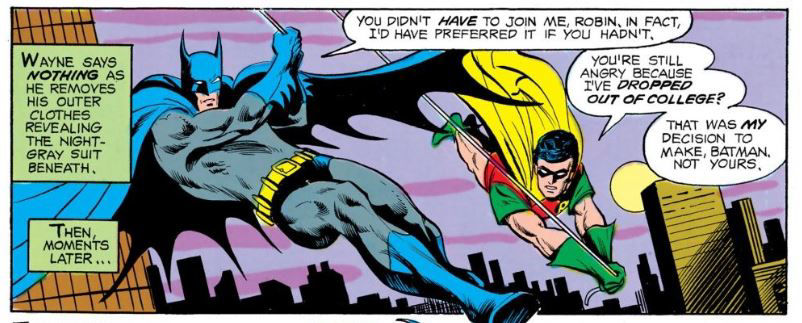
The recently-appointed Batman comics writer Marv Wolfman depicts the Batman as a stern paternal figure who so disapproves of Robin's decision to leave school that the Dynamic Duo are barely on speaking terms.

In Batman #330 (December 1980) Alfred tells Dick "Perhaps the time you two spent apart makes it difficult for Master Batman to accept having a partner again." But Robin believes it is something deeper.
The teenaged son of Bruce Wayne's business manager Lucius Fox had fallen in with a criminal crowd, and the Batman sternly lectures him -- displacing his frustrations with Robin onto young Tim Fox. Robin sticks up for his fellow teen and tells his partner they need to have a long talk. But mostly what Batman and Robin do is argue.
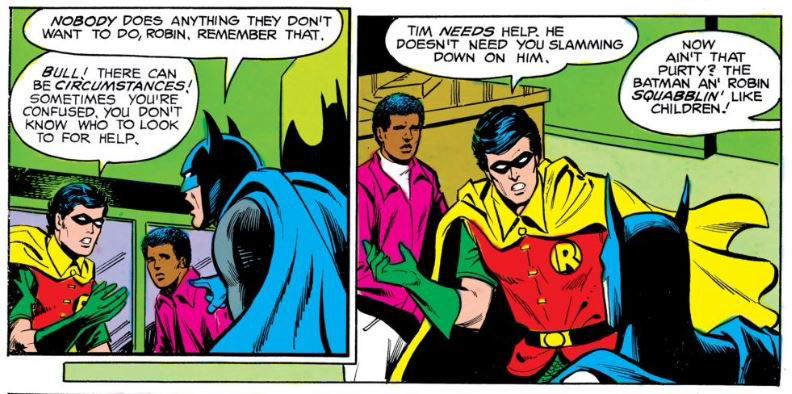
In issue 331, they attempt to have a conversation.
DICK: I'd like to talk about my decision to drop out of Hudson!
BRUCE: I'll talk about it with you all you want, Dick, but there's no way I can possibly approve! It's not that I don't think of you as an adult, Dick! It's --
DICK: That's just what is, Bruce! You can't get over thinking of me as a kid. As Robin, the Boy Wonder! Well, I'm not a Boy Wonder anymore, Bruce! I'm a full-grown man, a detective, just like you.
- Batman #331, written by Marv Wolfman
In the following issue, when Batman pays too much attention to the femme fatale Talia, daughter of supervillain Ra's Al-Ghul, Robin packs his bags and leaves the Batcave. He wails on a criminal who referred to him as "kid". "Kid? I've had enough with people calling me kid!" But Robin teams up with another femme fatale, Catwoman (who had semi-reformed at the time) to investigate another strand of Batman's case.
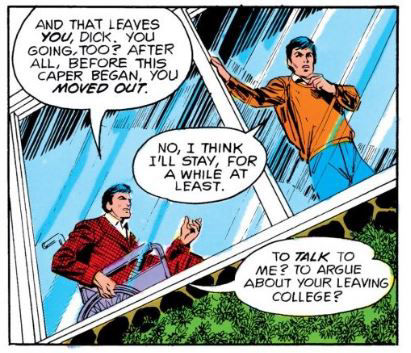
When the case is concluded in Batman #335 (May 1981), Dick decides he will stay for a while. When Bruce asks if he's staying to argue, Dick replies "No, we can talk another time. We still have years ahead of us." Actually, this was Marv Wolfman's last issue of Batman, and he was smoothing the ground for the succeeding writers who had a more cordial view of the Batman/Robin relationship.
But Wolfman wasn't finished scripting Dick Grayson's destiny. You see, Robin had another job.
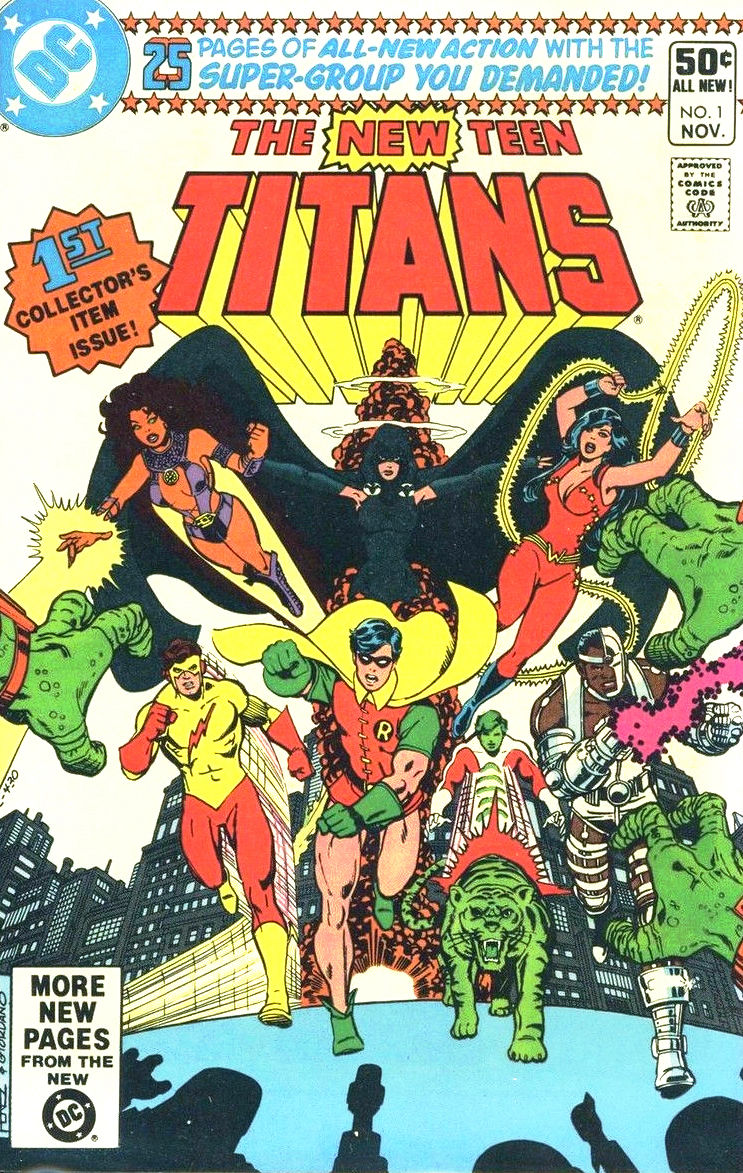
The original group of teen sidekicks had been a modest success with a Teen Titans comic that ran 43 issues between 1966-1973. The first Teen Titans revival ran only 10 issues between 1976-1978 and could be considered a modest failure.
When the concept was revived again in 1980 as The New Teen Titans by writer Marv Wolfman and artist George Perez, things had changed. The line-up had changed. Three of the sidekicks from the original run -- Robin, Wonder Girl and Kid Flash -- remained. Changeling (formerly Beast Boy), a guest star from the earlier incarnation returned as well. And this new Titans introduced three popular new heroes -- the mystic demon's daughter Raven, the African-American technology-based hero Cyborg and the orange-skinned alien warrior princess Starfire.
The style of the book had changed. This group of Titans balanced long-running action plots with soap opera style drama about people on the cusp of adulthood, all with some of the best art in the medium.
The readership had also changed. Rather than young children, many comic book readers were teenagers or in their 20s. Instead of buying comics off a newsstand or from a variety store, they would purchase their comics in specialty shops, devoted exclusively to comics. The censors that previously restricted the medium had less influence in this new market.
All this meant that the Wolfman/Perez incarnation of the Titans soon became DC's top-seller, far outselling the Batman comics.
Robin was the leader of the team and its best known member. But for the first couple of years he had the least amount of "screen time" in The New Teen Titans. The other Titans -- even the other kid sidekicks -- weren't regularly appearing in other books, and the New Teen Titans comic could explore their personal lives. But Robin still belonged to Batman, and the personal stuff belonged there.
By The New Teen Titans #20 (June 1982), Robin explained his dilemma to his teammates. He might be the team’s leader but when he was with Batman, he was still a kid.
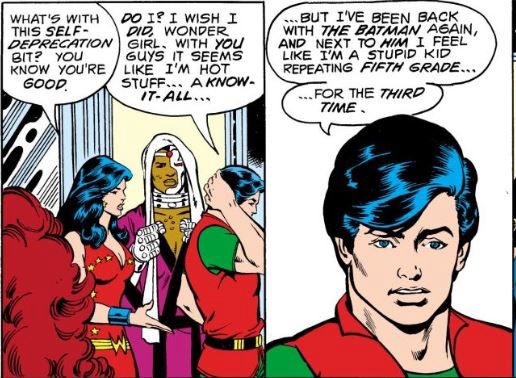
Wolfman's successor on the Batman comics, Gerry Conway featured Robin in a series of backup tales beginning in Batman #337 (July 1981) where the teen wonder reconnected with his circus roots to solve a murder. He then hitchhiked his way back to Gotham City, foiling a coven and drug smuggling operation. When Robin returned in Batman #344 (February 1982), things had changed. The Batman cracked a smile at the return of his partner. And Robin seemed to express none of the misgivings about their partnership he did when Marv Wolfman was writing the character.
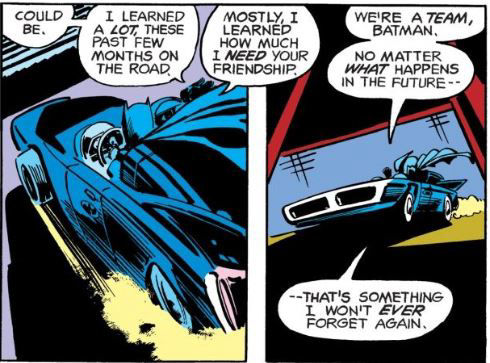
Complying with Bruce's wishes. Dick even returned to school -- although this time at Gotham University so he could stay close to home.
Conway wanted to restore some lost elements. The Batman and Robin faced off against some of the Batman's earliest foes from 1939 -- the Monk & Dalia and Doctor Death. Bruce Wayne resigned as head of the Wayne Foundation and the respected businessman role he'd played in the late 1970s and returned to the false front of a foppish playboy. Bruce and Dick moved away from downtown Gotham back into Wayne Manor. A loosening of the Comics Code in the early 1970s allowed Conway the freedom to develop storylines not unlike those of 1940 with a corrupt mayor in the thrall of gangster. But this time the action didn't take place in a small town or during a road trip. It was Gotham City who elected the shady Hamilton Hill, associate of mob boss Rupert Thorne. Mayor Hill fired Commissioner Gordon and replaced him with another lackey who issued a warrant for Batman's arrest. Batman and Robin had returned (only temporarily) to a Robin Hood-like outlaw status.
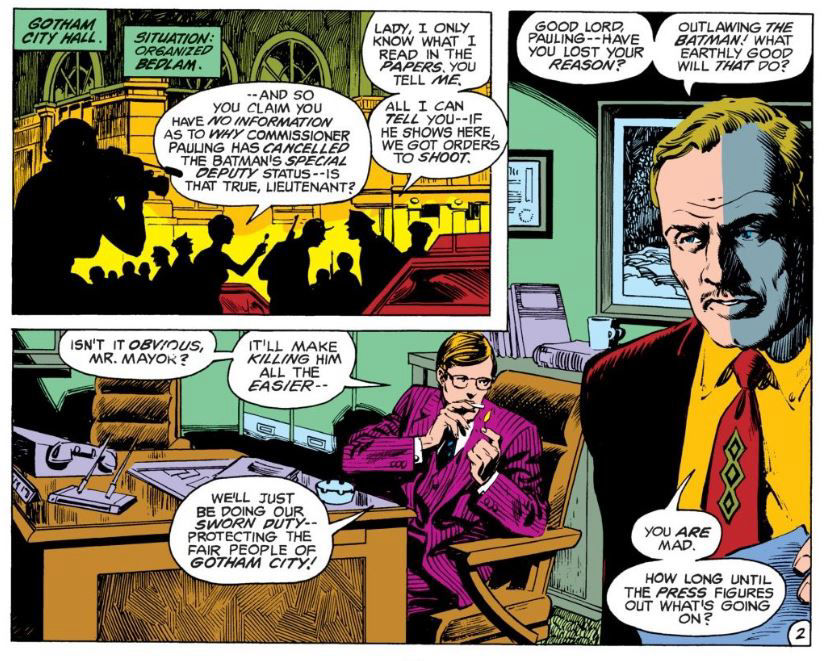
Conway liked the character dynamic with the Dynamic Duo, much for the same reasons that Robin was introduced back in 1940. It gave the Batman someone to talk too. But having a sidekick in his late teens seemed off-model. Conway, Batman editor Len Wein and managing editor (later vice president and executive editor) Dick Giordano didn't want the Teen Wonder. They wanted the Boy Wonder back.
And that was a problem.
In "Bat to Basics ... and Beyond: Batman Before the Dark Knight Returns" by Glenn Greenberg in Back Issue #50 (TwoMorrows Publishing, July 2011) the various creators explain what happened.
Wolfman’s plans were for Dick Grayson to mature and remain as Robin. But he explains the Batman group wanted something different.
And they wanted him to be the young partner again, because they felt that Batman needed Robin. What they wanted was the more youthful, fun type of character. I certainly understood that, but George and I were really seeing Robin as a very different character. It just made no sense to us for Dick to de-age.
-- Marv Wolfman, quoted in Back Issue #50
Conway confirms those plans and acknowledges the success of the Titans and Marv Wolfman’s importance as a writer:
… and Robin was very important to Marv’s stories in Titans. And to fully coordinate been what Marv wanted to do with Robin and what I wanted to do, I would have had to integrate elements of the Titans into Batman’s world, and that would have been a whole different vision.
-- Gerry Conway, quoted in Back Issue #50
Conway’s Batman was grounded in the crime dramas of the early 1940s Batman comics and the mid-1970s noir-styled run by writer Steve Englehart. It’s unlikely that the alien princess who was Robin’s potential love interest in the Titans would have fit into that world.
Wolfman’s prestige and the success of The New Teen Titans meant that he had the power to say no to Batman’s writers and editors. But instead, he offered a counter-proposal worthy of King Solomon. They could split the character in half.
I suggested “Why don’t you create a new Robin, and I’ll have Dick, who has been separating slowly from Batman over the last few years anyway, become his own person? Meanwhile, you create a brand-new one and create a sensation over the concept that for the first time in comics history, you’ve brought in a brand-new character to replace an old one in the same identity.” My position was, I want Dick Grayson – I don’t care if I have Robin. At 19 years old, wearing those short pants was pretty ridiculous.
-- Marv Wolfman, quoted in Back Issue #50
The Batman creative team would have preferred to keep the classic Bruce Wayne / Dick Grayson pairing, but they agreed to the new plan.
In Detective Comics #522 (cover date January 1983), Batman rejects the help of Robin and the Titans.
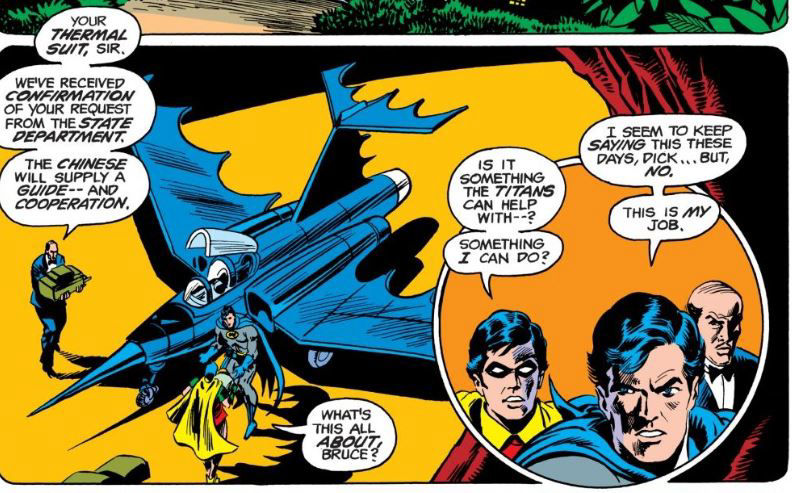
With the new agreement in place, Dick Grayson was allowed to express his feelings a little more in the New Teen Titans than he had been able to previously.
In New Teen Titans #26 (December 1982) as the Titans return from a mission to Starfire's home planet, Robin finally opens up to Starfire (aka Koriand'r or Kory for short). He explains that his problem is that he was raised by the Batman to be too introspective. It's a self-diagnosis that's easily confirmed in the uncertain way he views his non-platonic feelings for his team-mate.
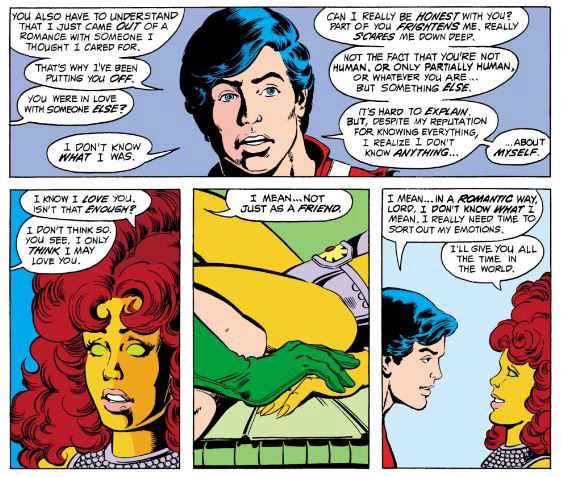
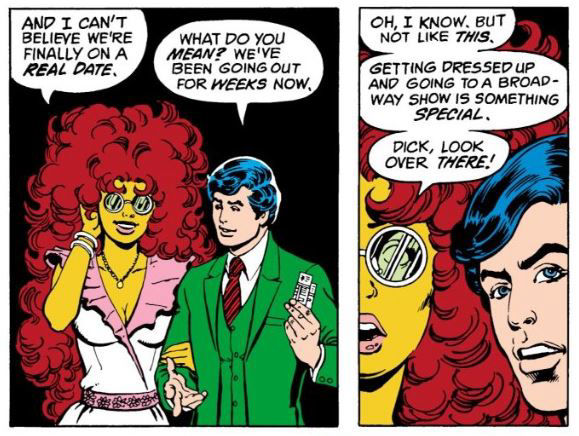
When Kory wants to say hi to New York's district attorney Adrian Chase, who is also in the line waiting to enter the theatre, Dick has to reminder his date that they know him in their Robin and Starfire identities, not their civilian ones.
While Dick Grayson is now free to have a meaningful relationship with Starfire, not everything is smooth sailing. Two issues later, Kory and Wonder Girl are worried about Robin -- he's moody, grumpy, overworked and stressed out by juggling college, the Titans and the Batman. The last being an impossible father figure to live up to. Kory says "He's just not driven the way the Batman is. He hasn't got that same fanatical obsession."
The conversation is interrupted when Dick arrives at the apartment. Wonder Girl leaves, and Dick snuggles with Kory. The dialogue and the erotic statue in the foreground suggest that more than snuggling is about to occur.
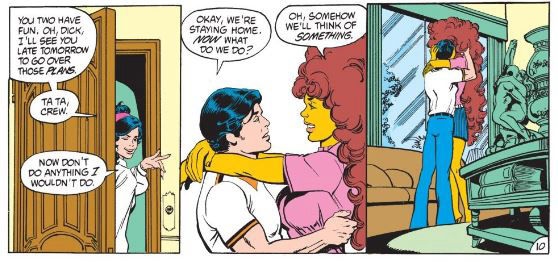
It's tame stuff by today's standards -- just as the implied sex in 1950s and 1960s movies that were produced under the film code seem to us today. But at the time, this was a very big deal. Here was a cartoon hero -- a figure on children's lunch boxes -- having a mature relationship.
And when we catch up with the lovers again later in the same issue, we're left little doubt that Dick and Kory are indeed lovers. Dick Grayson is now shirtless, and Kory is wearing a robe.
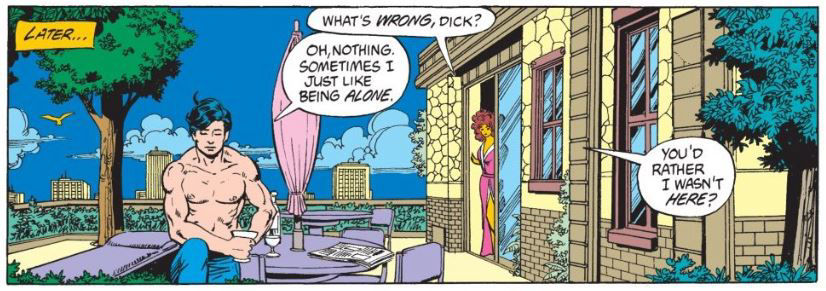
But the coital relations have not left Dick in a joyous mood. Instead the ex-boy-wonder is moodily thinking about another case. He's only had three hours sleep in the last three days and doesn't want to talk about their relationship. Kory offers a back rub, and Dick replies "Kory -- please! Don't you ever want to enjoy a bad moment? I just want to think!"
It's not surprising that Dick hasn't had time to think -- he's working two jobs. The New Teen Titans issue 28 has a cover date of February 1983, and that issue is mentioned in captions of the next month's issue of Batman, issue #357 when Dick returns to a Gotham City circus and meets the person who will finally allow him to break free from Batman.
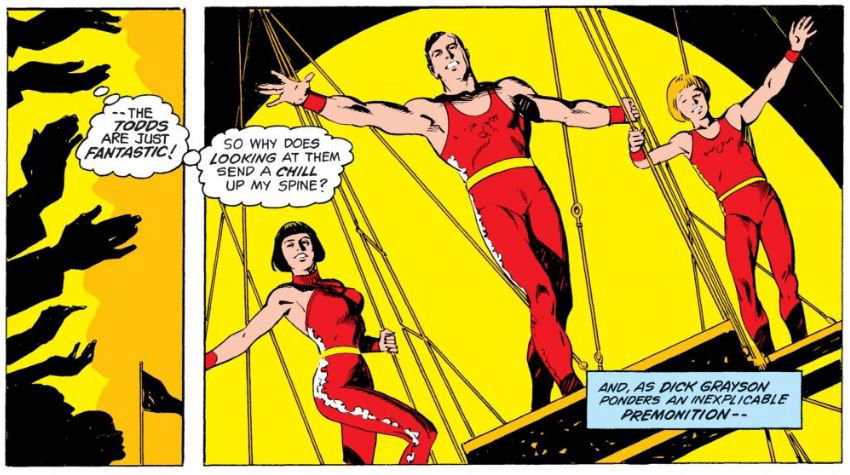
During this period the Batman comics were engaged in ongoing serialized storytelling. Batman and Detective Comics may have been separate series with their own numbering, but you wouldn’t know it from the stories themselves. An element introduced in an issue of Batman would carry over to the next issue of Detective Comics – both series were written by Gerry Conway.
In Detective Comics #523 (February 1983), Conway introduced a new villain for Batman – Killer Croc. In his initial appearances, Croc is hidden by a trenchcoat and fedora. A few issues later it would be established that he had a severe skin condition – giving him scaly skin, hence his name. Croc was a mobster who had designs on being the new mob boss in Gotham City. Croc’s plans would lead to the origin of the second Robin.
The new Robin’s origins call back to the original.
As detailed back in part 3, Dick Grayson grew up at a circus as part of the Flying Graysons trapeze act. His parents were killed in a protection racket. In Batman #357 (March 1983), Dick visits the Sloan Circus to meet up with Waldo, the clown from his own childhood in the circus. Waldo has a new act to show Dick.
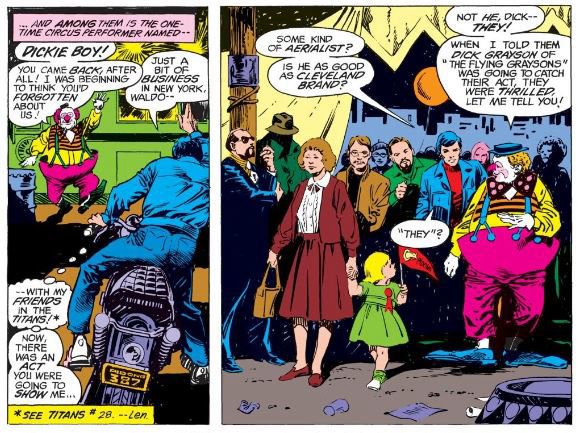
The Flying Todds are an aerial tribute to the Flying Graysons – Joseph Todd, Trina Todd and their young son Jason Todd. Dick is greatly impressed by their skill, but he feels uneasy – thinking back to the death of his own parents.
And Dick has good reason to be concerned, for in the same issue we see that the circus has other visitors – Killer Croc and members of her gang. Like Boss Zucco in the original Robin’s origin, Croc is running a protection racket.
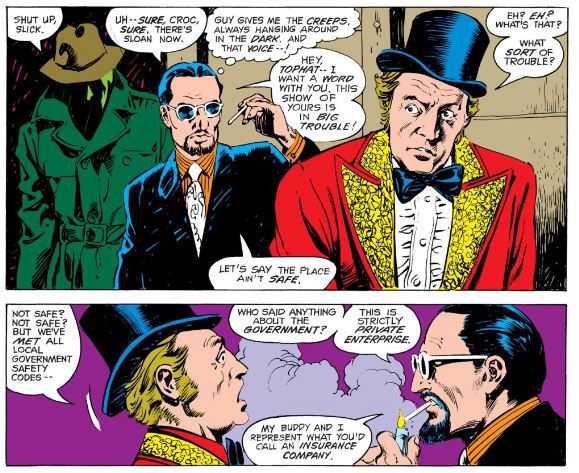
Things don’t quite play out like Robin’s origin back in Detective Comics #38 in 1940. Then, in just a couple of pages we met the Flying Graysons, saw their deaths and for Dick to don the Robin costume. With the more detailed and serialized storytelling of the 1980s, it took six issues (three of Batman and three of Detective Comics) to move Jason Todd into the same position. The Flying Todds storyline was only one part of the overall Batman narrative.
In the next issue of the arc, Detective Comics #524 (March 1983), Dick Grayson hosts a party at Wayne Manor – with the Todd family as the guests of honour.
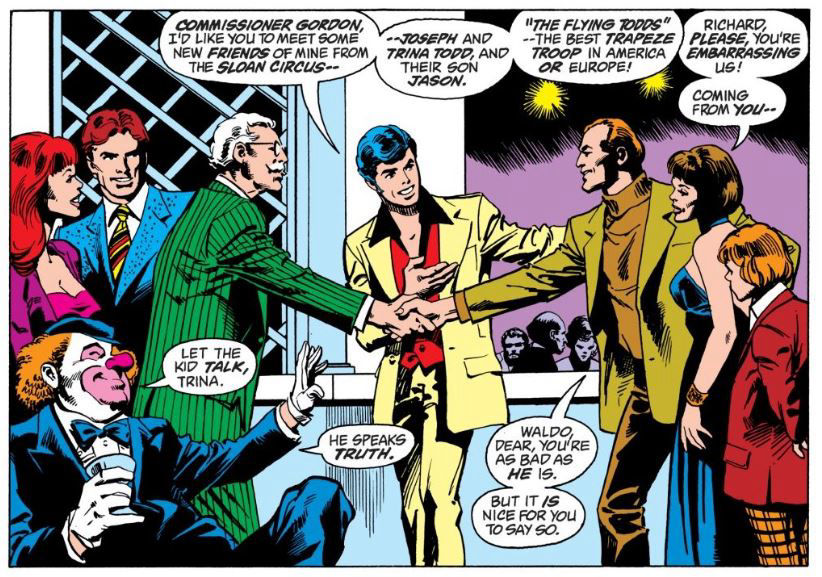
Batman returns home having been wounded in battle. When Trina Todd goes to speak to Dick in private about the problems at the circus, she finds the bandaged Bruce Wayne, with the Batman costume in his hands.
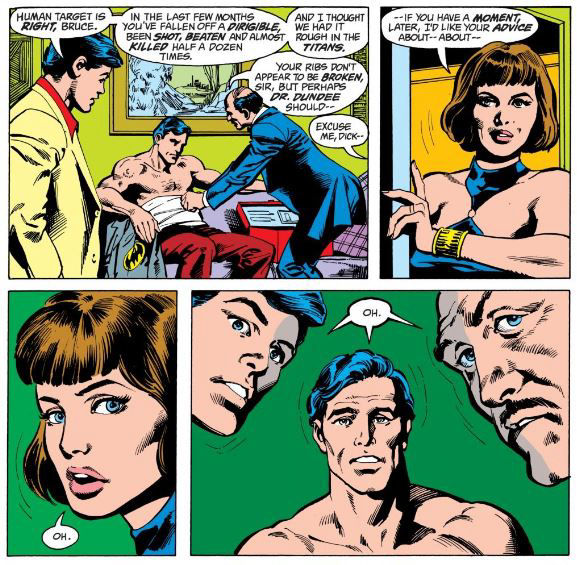
The next month in Batman #358 (April 1983), Dick confirms that Trina did figure out Batman’s identity. She spoke to Dick about the bulky thug in a trenchcoat who is running a protection racket at the Sloan Circus. Dick deduces that this thug is the same Killer Croc that Batman had just encountered.
Dick suggests that the Todds could keep an eye on Killer Croc, although Batman is reluctant to trust anyone else – a sign that the Caped Crusaders are drifting apart.
In Detective Comics #525 (April 1983), Robin visits the Sloan Circus. He asks for the Todds’ help. While Joe and Trina decide, Robin bonds with young Jason.
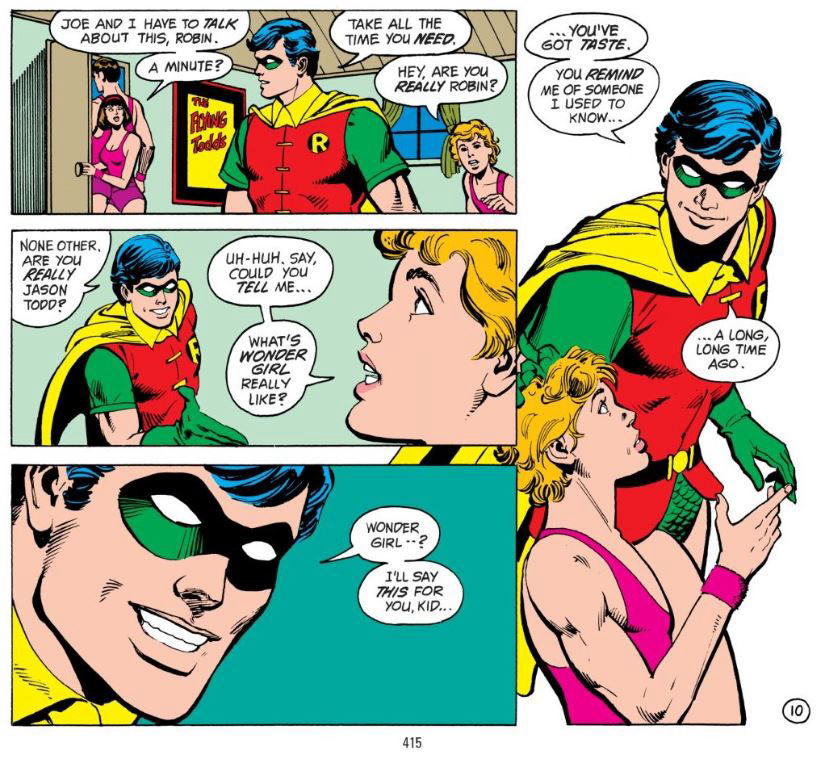
The Todds agree to help, and Robin assures them they won’t regret it. But they get a sense that the Teen Wonder might be wrong about that.
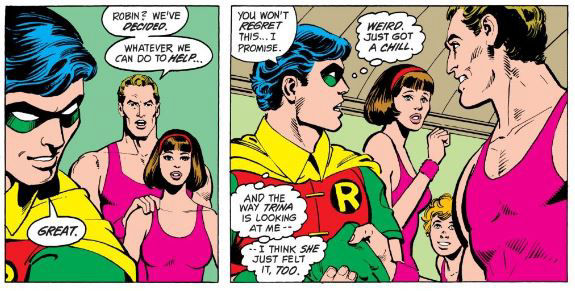
In Batman #359 (May 1983), Dick expresses concern that they’re asking the Todds to do something really dangerous. The tension of various events has gotten to Batman and he snaps at his young partner.
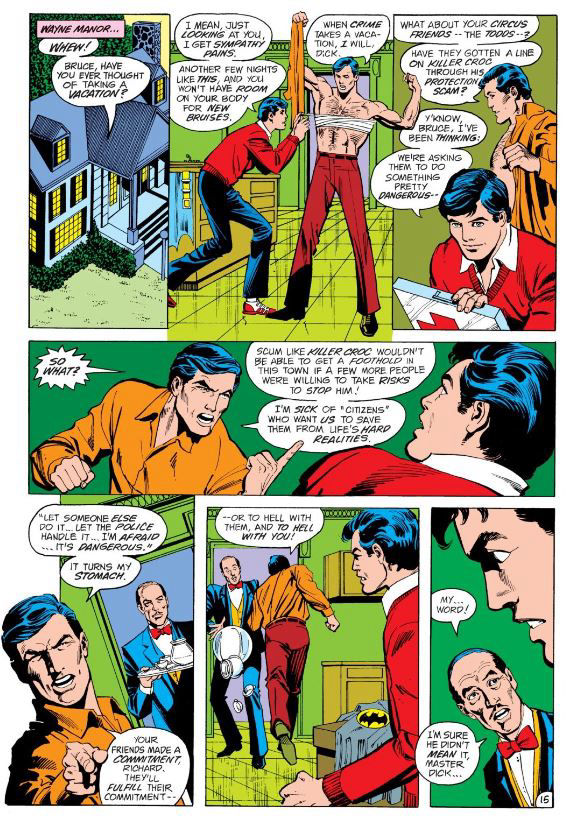
Dick heads to find the Todds at the circus, but he only finds Jason and their clown friend Waldo. Joseph and Trina Todd have followed one of Croc’s men back to his hideout at the Gotham City Zoo. On the last page, Killer Croc discovers the Todds. He promises to show them exactly what he has planned for the Batman.
Detective Comics #526 (May 1983) marked the Batman’s 500th appearance in Detective Comics. The milestone issue is extra-sized, and features some very special guest stars.
The Joker is jealous of Killer Croc’s plans to take over Gotham’s underworld. The Crown Prince of Crime summons the Batman’s greatest and most famous enemies together. He proposes they steal Croc’s thunder by teaming up and kill Batman first. The morally ambiguous Catwoman and Talia (daughter of Ra’s al Ghul, the closest thing Batman has to a James Bond style villain) both have romantic feelings for Batman and leave the villainous gathering to warn the Batman.
As Batman and the two femme fatales leave to stop the Joker, Dick arrives at Wayne Manor with Waldo and Jason Todd. The manor has another visitor as Batgirl lurks outside to warn Bruce and Dick about the villains amassed against them.
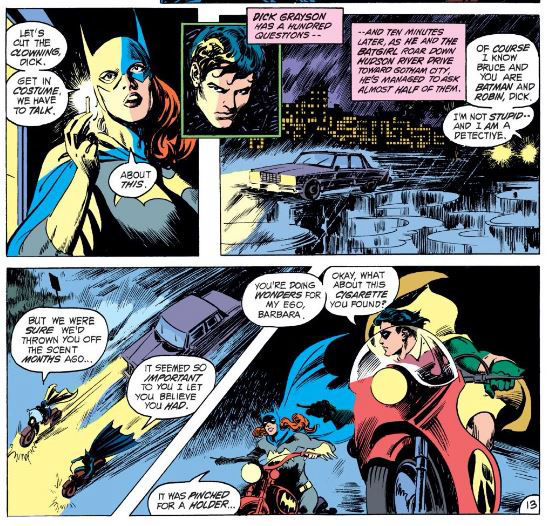
Batman, Talia and Catwoman fight various villains. Meanwhile, back at Wayne Manor, Jason Todd goes exploring and discovers the entrance to the Batcave – and learns Bruce’s secret.
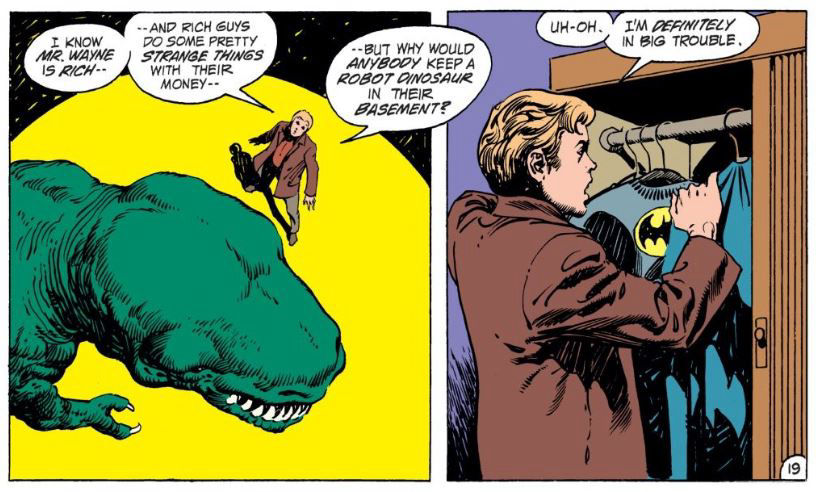
Robin and Batgirl make a far more gruesome discovery when Commissioner Gordon radios them to say that one of Killer Croc’s cars was found at the Gotham City zoo. Commissioner Gordon reveals that Joseph and Trina Todd’s dead body were found in the reptile pit. “You brought them into this, Robin,” the commissioner accuses. “It’s on your head.” Robin takes that very much to heart.
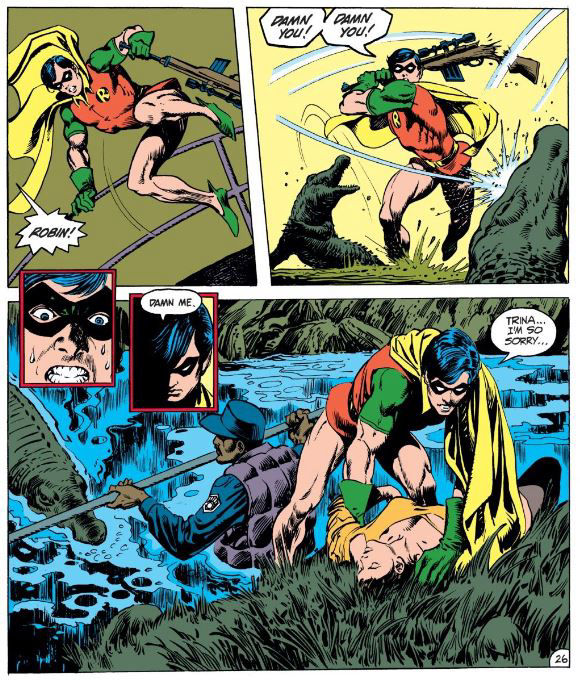
Meanwhile in the Batcave, Jason finds a truck of discarded costumes from Robin’s childhood and assembles a costume for himself.
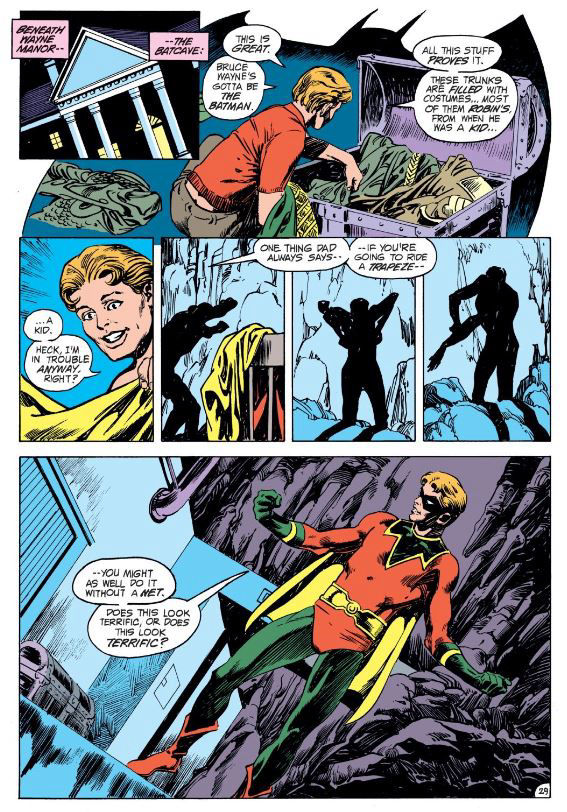
When Batman, Catwoman and Talia temporarily return to the Batcave to get a fix on Killer Croc and the Joker’s location, Jason hides in the trunk of the Batmobile and secretly joins them as they head out again.
Batgirl and a furious Robin fight their way across the town’s mobsters, learning that Croc has lured Batman into a trap at the Adams Brewery at Clark and Main. They arrive to help Batman, and Batgirl shouts out they found the Todds’ bodies at the Gotham City zoo. Just then, Jason Todd jumps down to save Batman from Killer Croc. He processes what he heard about his parents’ deaths and freaks out.
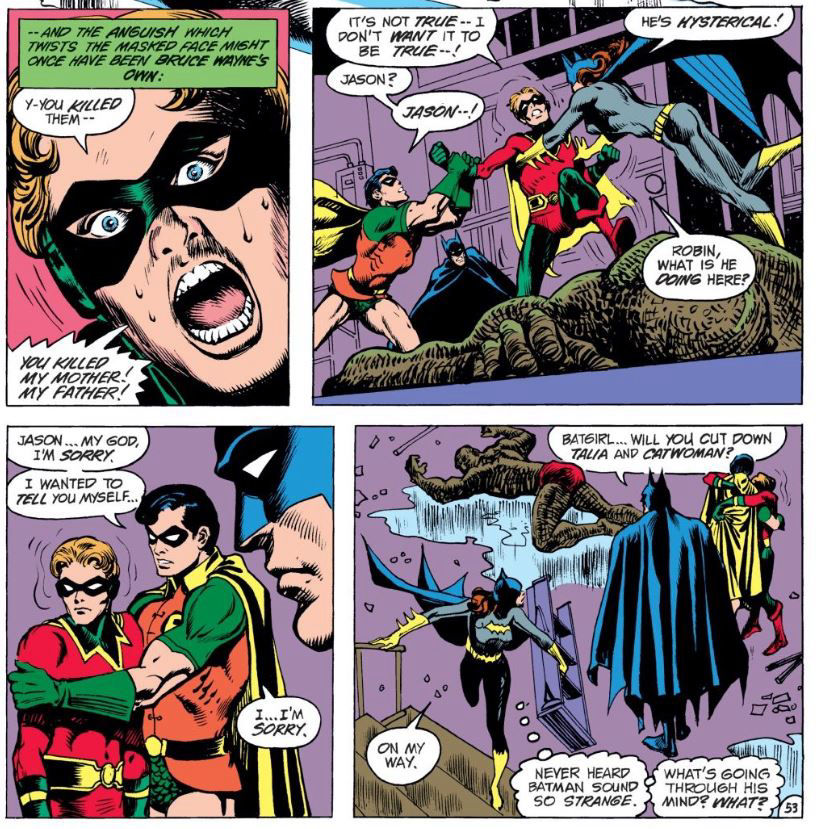
At Wayne Manor, Dick Grayson reflects on how he is the one that brought the Todds into this fight. He wants to make it right. Dick wants to adopt Jason. But Bruce Wayne feels responsible too, and takes Jason under his wing instead.
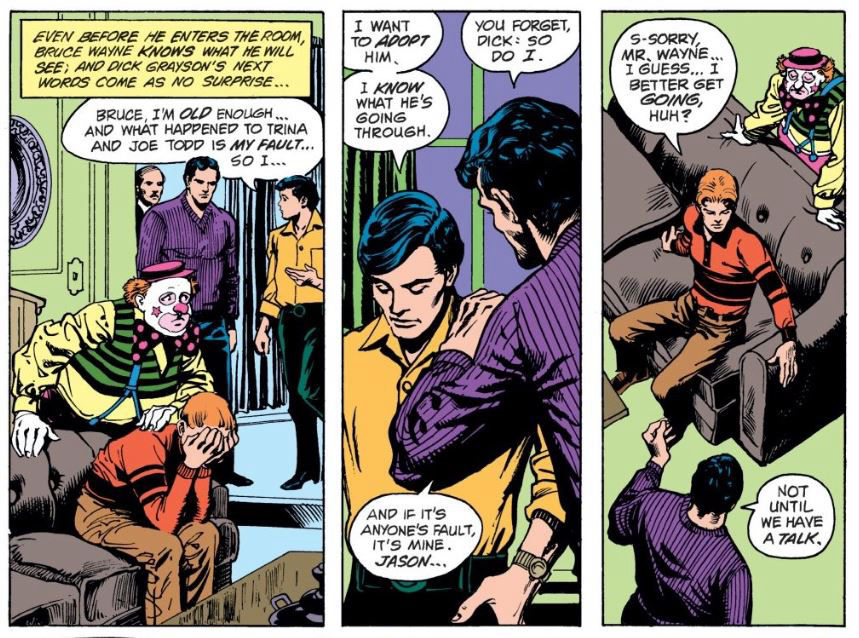
Dick tells Alfred they’re going to need to open up his old room -- it's clear that Jason will be moving in. And at this point, it would seem like the new Robin is ready to spread his wings.
But that doesn’t happen. This is Gerry Conway’s last Batman issue. Next month, `Batman #360 (June 1983) sees the introduction of new writer Doug Moench. While Jason trains with Batman, the hero leaves his ward behind when he goes into action. The original Robin might have been the same age as Jason, but Batman says that was possibly a mistake. “One I don’t care to repeat.”
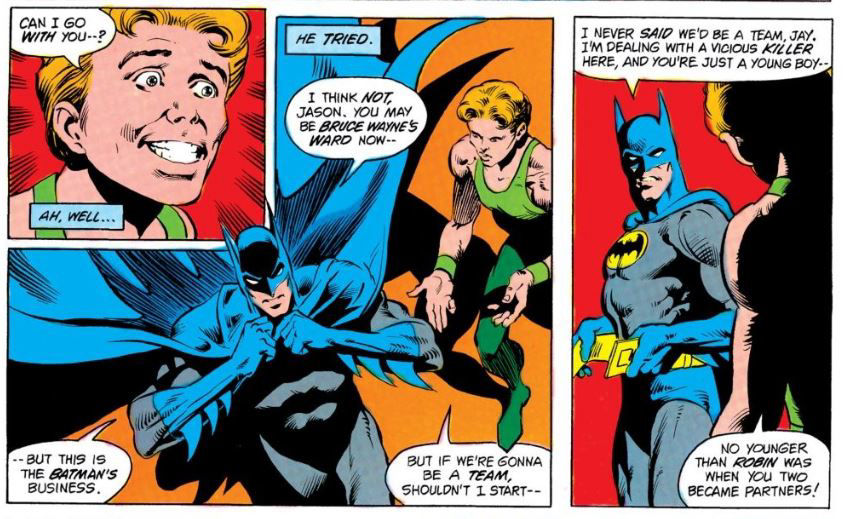
So, what happened?
In Back Issue #50, Moench suggests that DC was still trying to make up their minds whether Dick Grayson would stay Robin and instead Jason would take on a new identity when he joined Batman on adventures. This delay gave time for Marv Wolfman and George Perez to further develop Dick Grayson over in The New Teen Titans.
In the Batman comics, Robin seemed relatively in control of himself – every bit the role model that the toy sales and lunch boxes required him to be. But over in The New Teen Titans by writer Marv Wolfman and artist and co-plotter George Perez, that was decidedly not the case.
In New Teen Titans #29 (March 1983), a very angry Dick Grayson works out in a regime that brings the possibility of real injury. Nothing seems to satiate his anger. His teammate Wonder Girl tries to talk him down, saying that he has too much on his plate for anyone to handle. But Dick won’t listen.
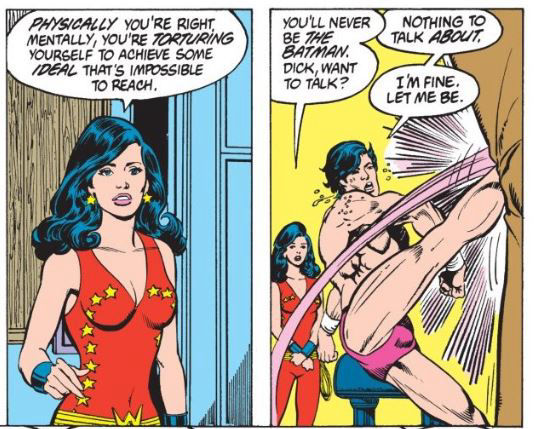
Dick’s attitude is beginning to affect Kory. Wonder Girl advises her to give Dick some space and do things for herself. She also tries talking to Roy Harper aka Speedy, Green Arrow’s former sidekick and an original Titans member who recently hooked back up with the new version of the team. Roy hits on Kory – something that makes Dick even angrier
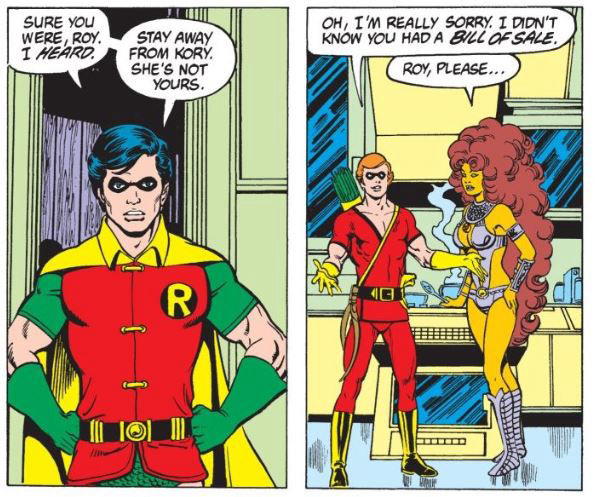
Robin isn’t the only Titan with stress. In issue 31 (May 1983), the team argues among themselves and Dick thinks about quitting and just turning over leadership to Donna Troy aka Wonder Girl.
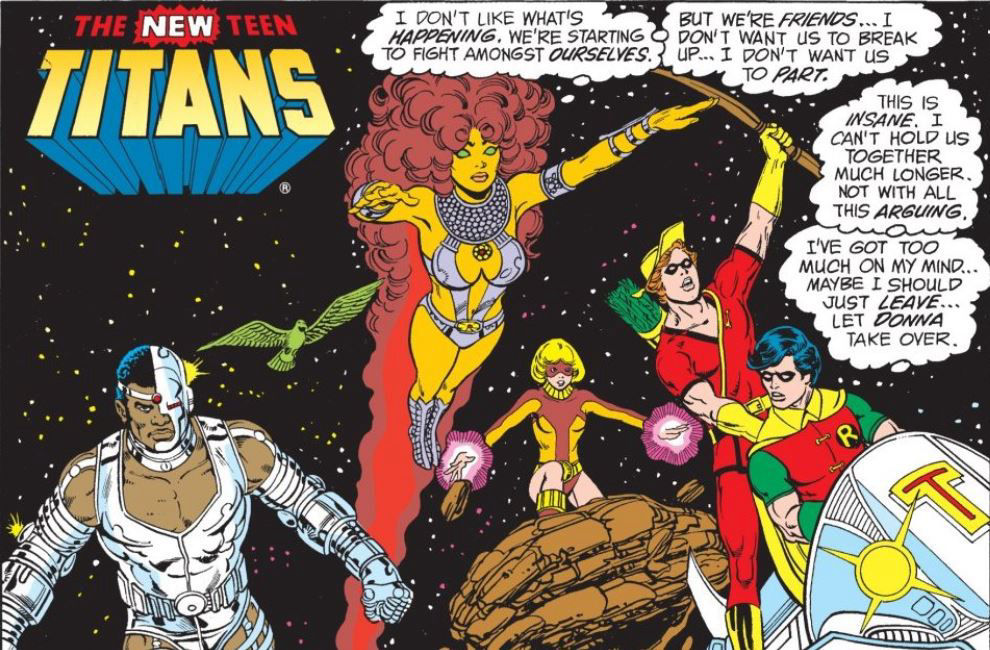
Again, Starfire tries to speak with Robin. He apologizes for how he’s been treating her, but again the Teen Wonder doesn’t open up. He wants to be left alone.
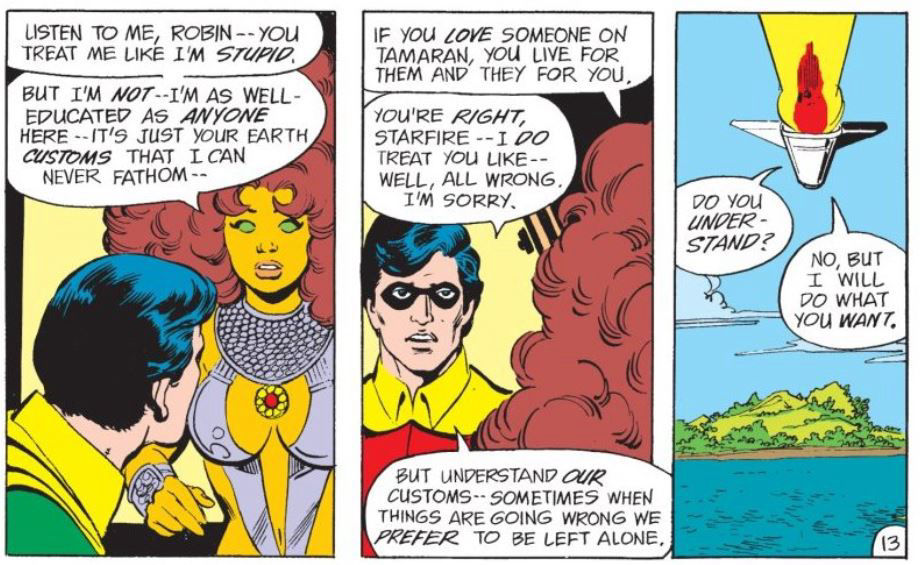
The next month in issue 32, Robin once again thinks how he can’t hack it.
But all his teammates see is how closed off he is. Kory wonders if he cares for her, and Donna wonders if Dick cares for everyone.
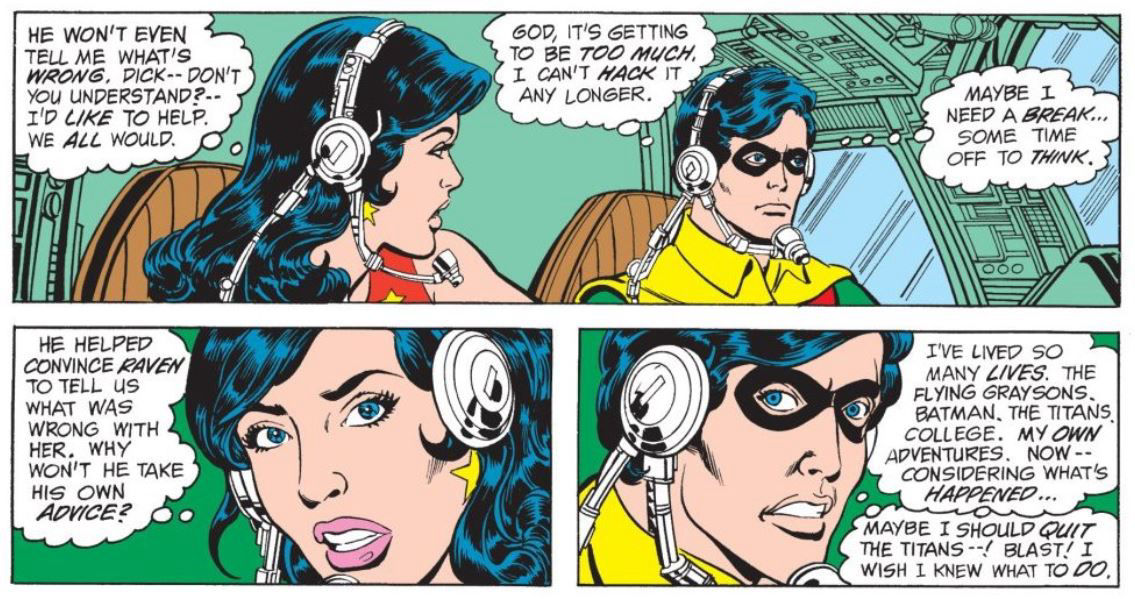
Finally in New Teen Titans #33 (July 1983) the Titans learn one of the things that has been troubling Robin. Starfire visits Wayne Manor to look for Dick, but instead she meets Jason Todd. She’s shocked to learn that Dick has moved out of Wayne Manor. She later checks and sees he’s not staying at any college dorms.
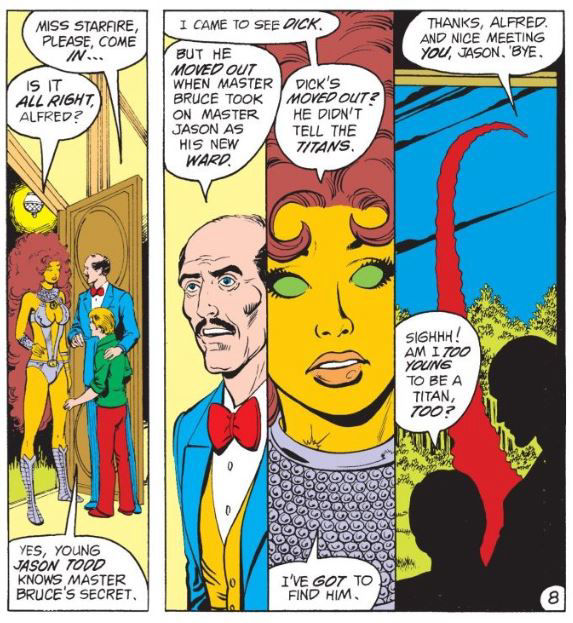
As for Dick’s whereabouts, he is helping New York's disgruntled District Attorney Adrian Chase hound and harass crime boss Anthony Scarapelli, who had been freed on a technicality. For several issues, Chase has been railing against the limits of the law, and back in #26, Robin saw something of The Batman in Chase’s attitude.
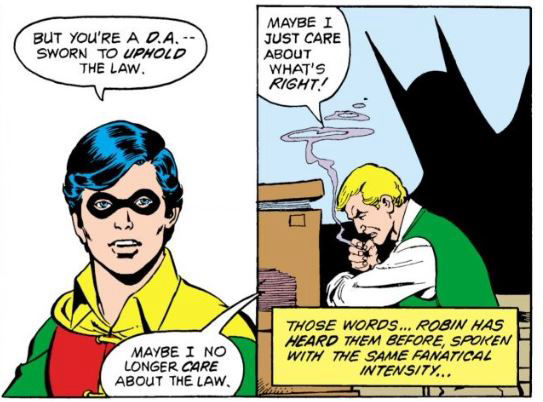
Issue 33 ends with Robin and Chase smashing into Scarapelli’s mansion. The next issue as they fight the crime boss’s thugs, Robin reflects on the illegality of this action.
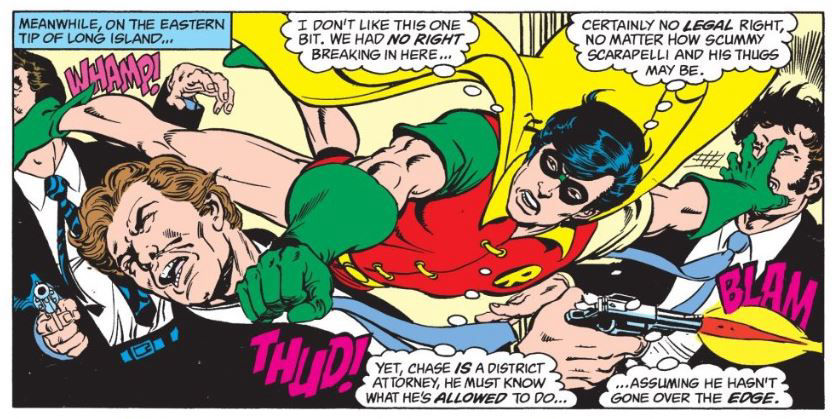
However, it turns out that Chase did have a search warrant and wanted Robin to use his rights as a special deputy to make an arrest. Robin is not pleased at being used. Chase is stepping outside the normal confines of the law, and he's using Robin's unusual status as an authorized vigilante to do it.
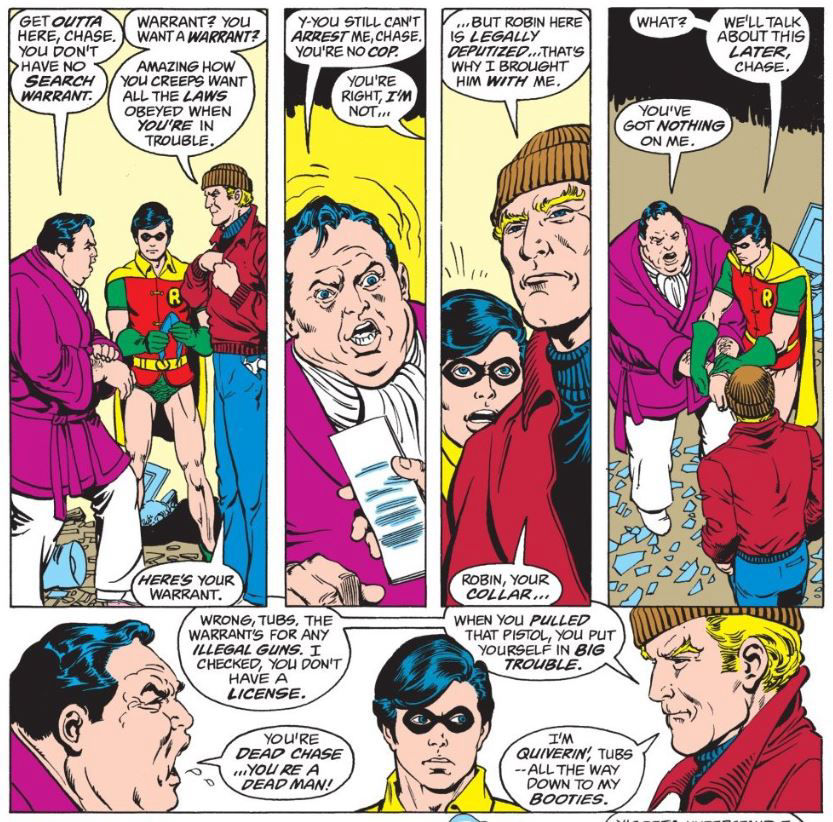
As before, Chase's violent fanaticism reminds Robin of the Batman. And readers familiar with Batman's history might be reminded especially of some of the earliest Batman stories (including Robin's own origin) where they were vigilantes acting far outside the law.
And while Chase might have paid token respect to the letter of the law, he has gone far against its spirit. Robin expresses his strong dislike of Chase's methods:
ROBIN: My God -- if you had a warrant, we didn't need to break in like that.
CHASE: I wanted Scarapelli to know he couldn't escape me.
ROBIN: But you're a district attorney. You're supposed to obey the law.
CHASE: The law is useless. Only justice counts.
ROBIN: My God. And I thought the Batman was obsessed.
-- New Teen Titans #34 (August 1983)
As Robin storms angrily out of Chase's apartment, he looks back to see the apartment explode into flame.
The storyline concludes in New Teen Titans Annual #2 (1983). Chase's wife and children were killed in the blast and the DA was critical wounded. In reaction, Robin embraces Chase's hardline and barely-legal stance, even ignoring a restraining order, to hound Scarapelli.
Starfire and the other Titans are concerned and hesitant to embrace Robin's renewed vigilantism. Starfire aka Koriand’r aka Kory is an alien warrior princess – known for her temper in battle, but now she has to talk Robin down from his own battle rage. In her lecture, she mentions the love that Robin and her feel for each other.
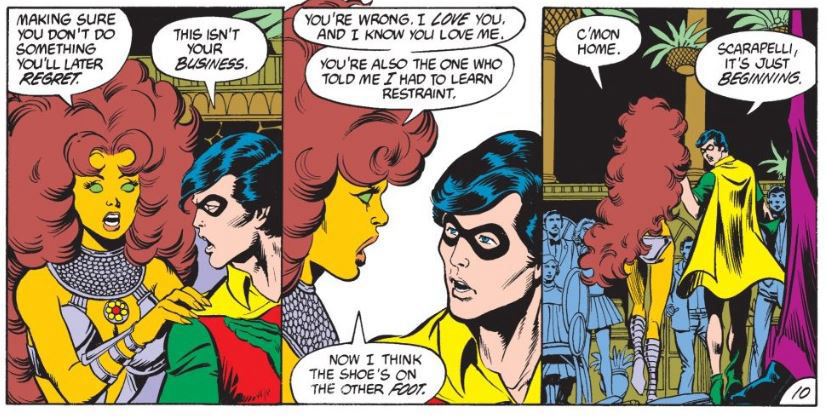
Robin and Starfire continue their conversation on the rooftop. As both Wonder Girl and Starfire have done for several issues, Kory tries to get Dick Grayson to stop pushing himself. She notes how much he’s changed from the fun-loving person she first met – the Robin familiar to those of us who grew up on the Batman TV show or read classic comics. And again, she declares her love.
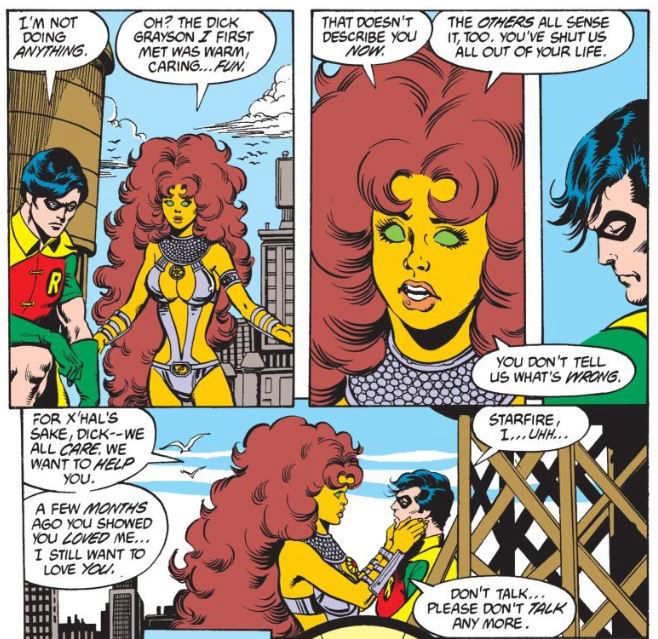
What the two lovers fail to notice is that they are in the crosshairs of one of Scarapelli’s hitmen. But a mysterious figure has the hitman in his own sights, and assassinates the assassin before he can shoot Robin and Starfire.
Robin decides that he might be bound by a court order, but his friends aren’t. He wants the Titans to pursue Scarapelli for him. "I know it isn't completely legal, but in this case, the end justifies the means. Are you with me?" Wonder Girl replies "Robin, you're our leader and we care for you. But we won't break the law for you." The Titans vote and agree to investigate Scarapelli, legally.
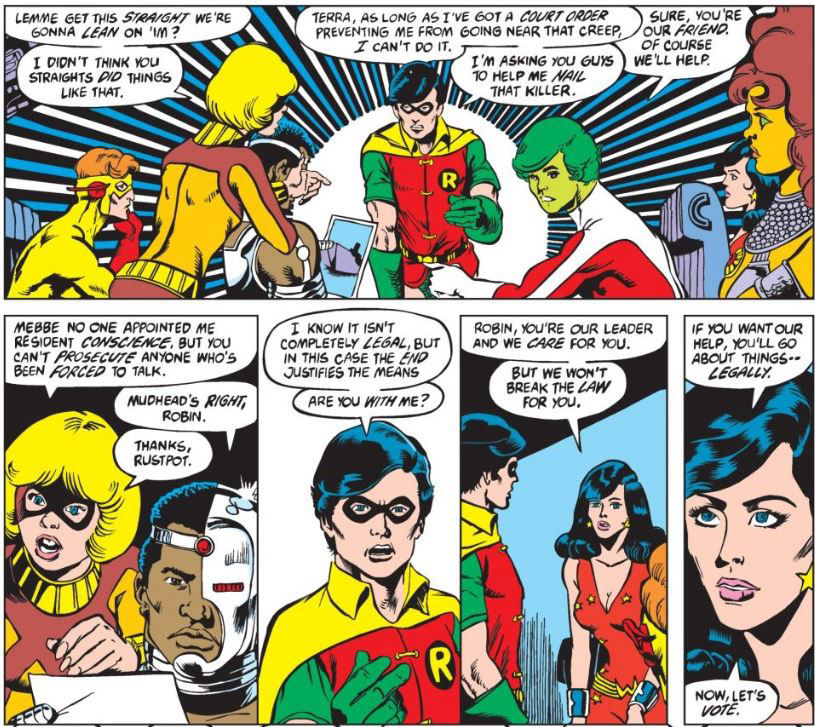
The Titans break up Scarapelli's forgery ring, his arms smuggling operations and his rigged casino. It resembles Batman’s war on Boss Zucco back from Robin’s origin story back in Detective Comics #38 from 1940. And yes, it resembles Robin Hood busting up the Sheriff and Prince John’s various rackets in movie montages.
For decades the self-censoring code that comic books subscribed to prevented them from glamourizing criminals. One way the Robin Hood comics got around this was for the medieval hero to point out that the Sheriff of Nottingham and the robber barons were the true thieves. The same could be said here, where the Titans are combating the "real" criminals. For example, Kid Flash discovers the gambling tables are rigged. But breaking up the casino, they are just stopping a cheater.
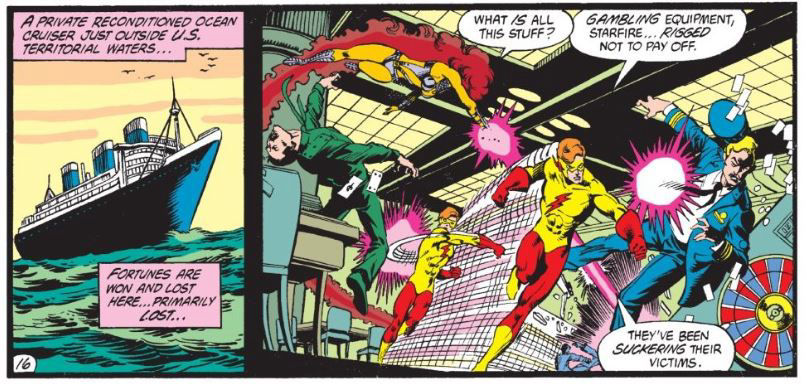
But Wolfman and Perez ask more probing questions about this kind of behaviour than earlier comic books ever did.
While the Titans foil of Scarapelli’s illegal operations, they find nothing to these schemes back to the crime boss.
Robin taps away at a computer trying to find some connection, some link to make charges stick. Wonder Girl asks Robin to answer "without the typical Robin angst" why they couldn't just ask the police to break up those operations. He replies he couldn't find anything tying Scarapelli to those operations, and asks for time to prove it.
That Wonder Girl thinks “angst” is Robin’s defining characteristic shows just how far he’s come from the 1940s conception when “laughing” was Robin’s defining adjective.
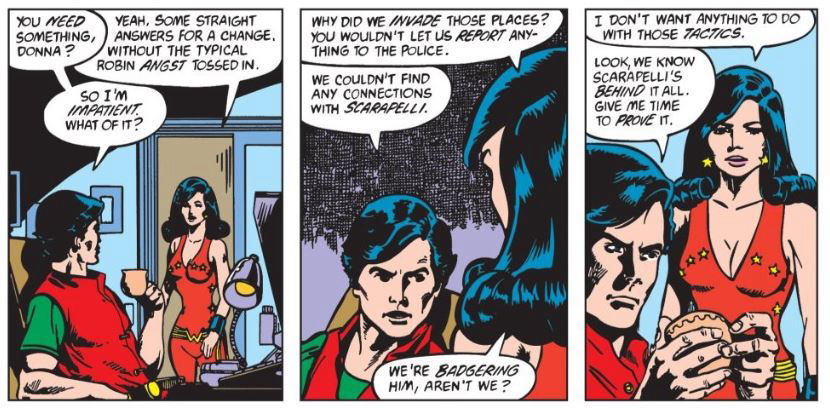
As the investigation continues, Wonder Girl continues to protest. "We've always worked with the law, but now you're turning us into vigilantes." Robin plays a recording that Chase supposedly made before his injury that rallies the team and sends them to stop a mob war in the desert. But Robin isn't with them.
In his home, Scarapelli is confronted by an armed intruder wearing a body suit and a full-face mask similar to a ski-mask. "You are guilty against your fellow man," the intruders declared. "If you were poor, if you were an ordinary man, you would have been imprisoned years ago ... Your wealth cannot buy me." Scarapelli flees through his home, demanding to know who his mysterious attacker is. The intruder pulls off his mask to reveal the face of District Attorney Adrian Chase. However, Chase declares "Adrian Chase is dead. I am... the Vigilante!"
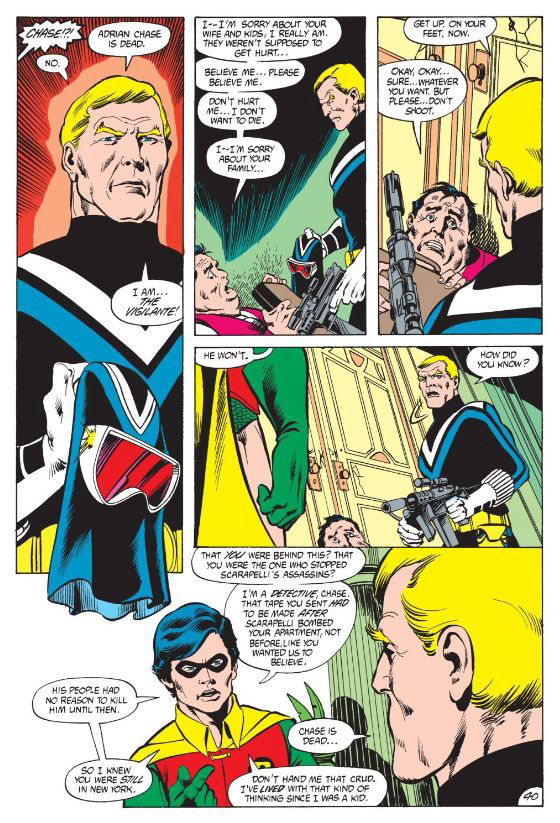
Robin appears on the scene. He'd realized that Chase's recorded message was made after the attack on Chase and his family, not before. He came to Scarapelli's to stop Chase. "Chase is dead ..." the Vigilante intones. Robin responds "Don't hand me that crud. I've lived with that kind of thinking since I was a kid." Robin says "If you believe in the law like you say you do, you'll let me take Scarapelli to trial. But if you shoot him, you'll be as bad as he is."
But the Teen Wonder is knocked aside, unconscious, as Scarapelli and Chase fire at each other. Only Scarapelli's body is found. Robin protects Chase's name by saying he was unconscious at the time of Scarapelli's death, so he doesn't know who killed him. He stays silent about Adrian Chase's role in events. Robin looks ashamed of his lie of omission.
In Robin's origin story, the Batman and the Boy Wonder seemed perfectly happy to illegally harass Zucco and watch him die. Both Batman and Robin changed since the earliest days – even those early days were softened in modern retellings. But Chase stands in for the kind of hardcore, armed vigilante that Batman once was taken to the extreme. (Much like the Marvel Comics villain turned anti-hero The Punisher.)
I have to think the similarities to the Zucco case are completely intentional – a look back at what once was, so that Robin can move forward. Chase stands in a pseudo-father figure like Batman. Now Robin rejects the past -- the outlaw methods of both the Batman and Robin’s own namesake Robin Hood.
There's another subtle shift in the story. Throughout New Teen Titans Annual #2, the media reporting on events refer to Robin as "Batman's junior partner." On the last page, the TV reporter describes him as "Robin, leader of the New Teen Titans."
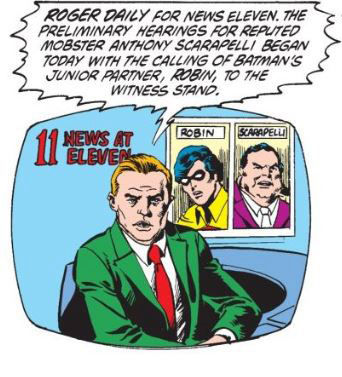
Batman's Junior Partner
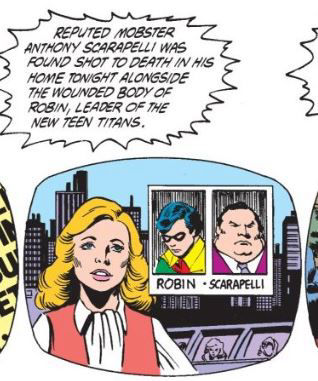
Leader of the New Teen Titans
Dick Grayson may have changed greatly from his time as "the laughing young Robin Hood of today" that he was in his earliest appearances. He may embrace the law over outlawry. But Robin was coming to embody another trait of the legendary Robin Hood -- he was now a leader. And it would be the issue of leadership that would lead to his break with the Batman.
In New Teen Titans #36 (November 1983) Robin's self doubts continue to plague him as thinks to himself that he's been "a complete jackass. Running off with Adrian Chase, breaking God knows how many laws. I've been screwing up all over the place of late. I've got no right to be leader here." But one month later, Robin would prove his leadership both to himself and to the Batman in a crossover team-up between The New Teen Titans and Batman and the Outsiders.
In New Teen Titans #37 (December 1983), the Titans and the Outsider encounter each other on a case, and both summon their respective leaders. As it happens both leaders are at Wayne Manor having a momentous conversation.
DICK: It's about time, Bruce. I'm 19. No longer a kid. And going up against vigilante crystallized my thoughts. I've realized that my ideas of justice and yours have become radically different.
BRUCE: I don't like what you're saying. Do you want to officially end our friendship?
DICK: Our partnership ... as in Batman and Robin. Not our relationship as Bruce Wayne and Dick Grayson.
JASON TODD: Hey, are you joking? Can I become the new Robin?
DICK: Jason, I didn't say I was giving up being Robin. I've been playing that role since I was 8.
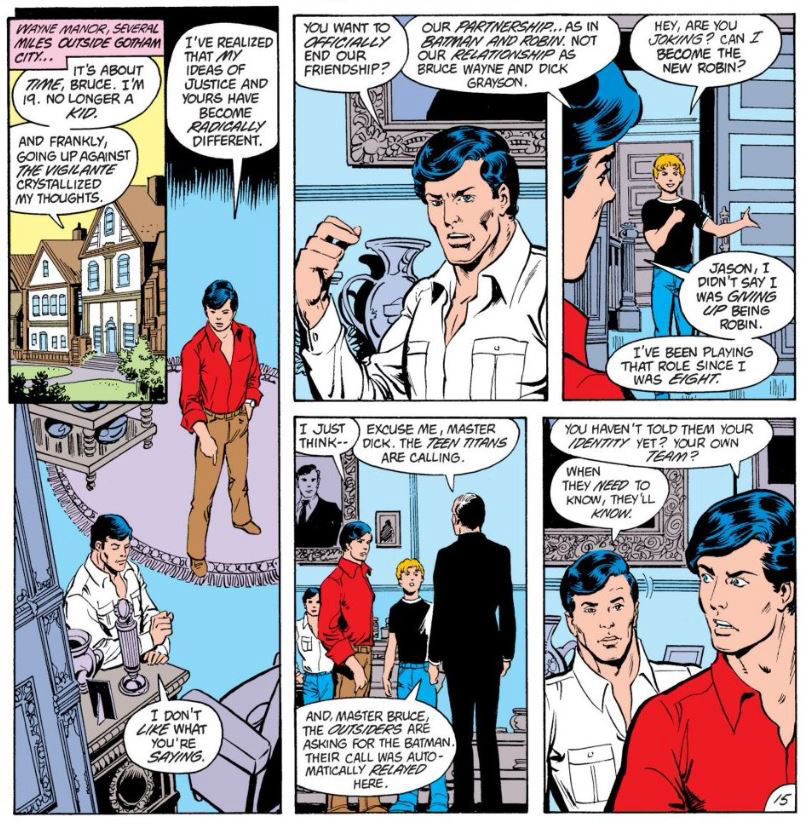
Alfred the Butler interrupts as both the Outsiders and the Titans are calling in. Dick is surprised and annoyed when he realizes that Batman hasn't shared his secret identity with his team. "When they need to know, they'll know." The Batman takes charge of the investigation, much to Robin and the Titans consternation.
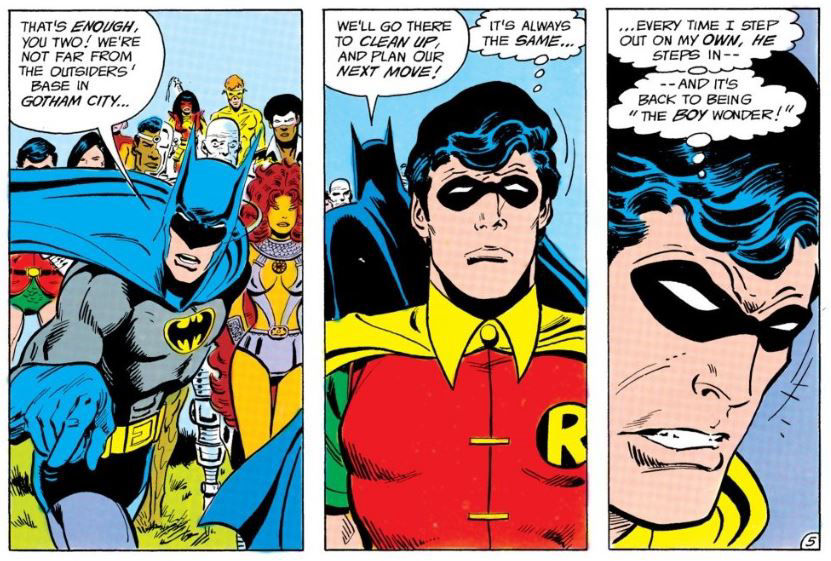
In Batman and the Outsiders #5 (the second half of the crossover, written by Mike W. Barr with an assist by Titans writer Marv Wolfman and art by the legendary Batman artist Jim Aparo) Robin thinks "It's always the same... Every time I step out on my own, he steps in --- and it's right back to being 'the Boy Wonder'." Starfire confides in her teammate Kid Flash "I know the Batman is on our side, but I don't like the way he treats Dick.""Neither do I, Kory. But Robin's been his sidekick for years ... and that kind of attitude is hard to change --- Take it from Kid Flash."
Finally Robin has to countermand one of the Batman's orders. "Robin, you're out of line --""The hell I am! I know the Titans better than you, and I know more about running a team than you! I won't let you endanger us all, just because you like to be in charge!"
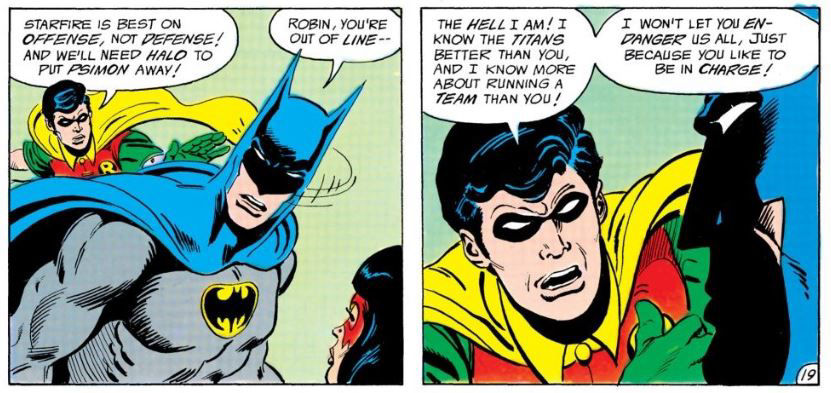
The Titans and the Outsiders manage to beat the Fearsome Five, thanks to Robin's leadership. The Batman admits "You lead the Titans well, Robin -- I guess even the teacher can learn from his pupil ... his former pupil.""Thanks, Batman!" Robin replies adding "But you know what they say ... A pupil is only as good as his teacher... And I had the best there is." The now former partners shake hands.
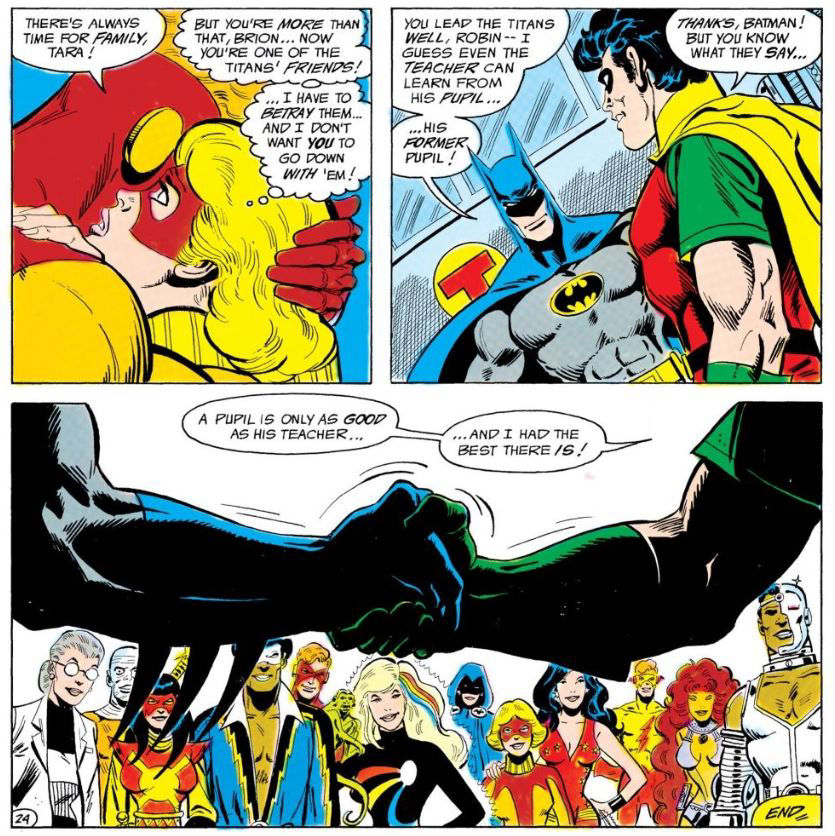
The Dynamic Duo also shook hands in the iconic animated opening of the 1966 live-action Batman TV series. But here it is different – not a complete goodbye but more a passing of the torch.
Then in The New Teen Titans #39, Dick Grayson shows how much he has learned from his mentor Batman, often billed as “the World’s Greatest Detective”. Robin uses his own considerable skills to track down information about the true parents and adopted parents of his orphaned teammate Wonder Girl in “Who is Donna Troy?” Donna wanted to know who she was and where she came from before she married her college professor fiancé.
It was an important piece of closure for Donna to move forward, but solving the mystery also allowed Robin to move forward and take the really big step at last.
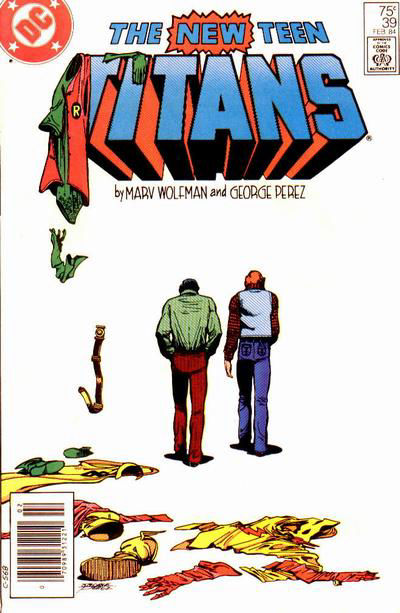
In New Teen Titans #39 (cover date February 1984, but on sale in November 1983) features big changes. Wally West aka Kid Flash announces that he's giving up the superhero gig again to concentrate on his university studies. Dick Grayson takes the big step toward independence when he tells his shocked friends that he's giving up being Robin. Starfire asks him to reconsider, but he explains "Don't you see, Robin will always be the back half of 'Batman and ..'"
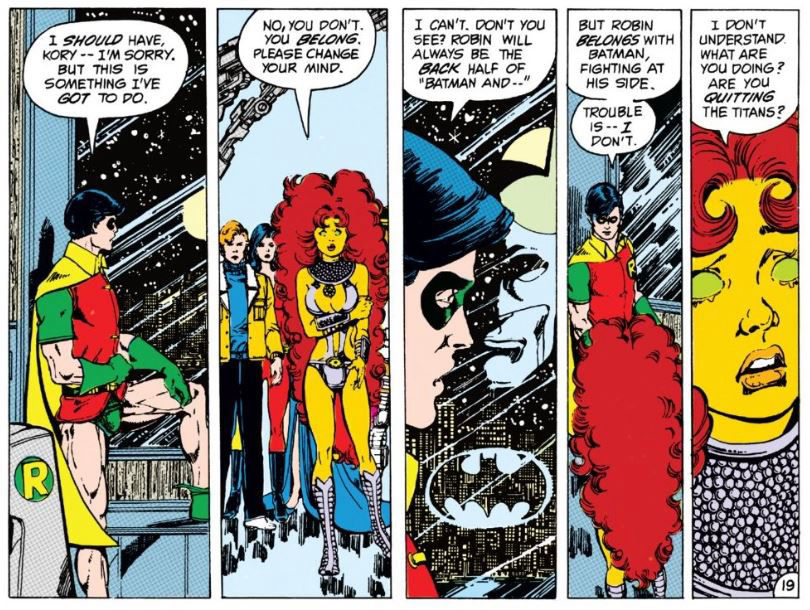
Kory is especially worried. Perhaps she feels he’s pushing his friends away again. But Dick clarifies he’s not leaving. In previous issues he’d thought about leaving the team. But now he’s embracing the Titans more than ever. He’s just giving up his role as Robin and being plain Dick Grayson "until I can decide what I am becoming." He starts to strip off his Robin costume.
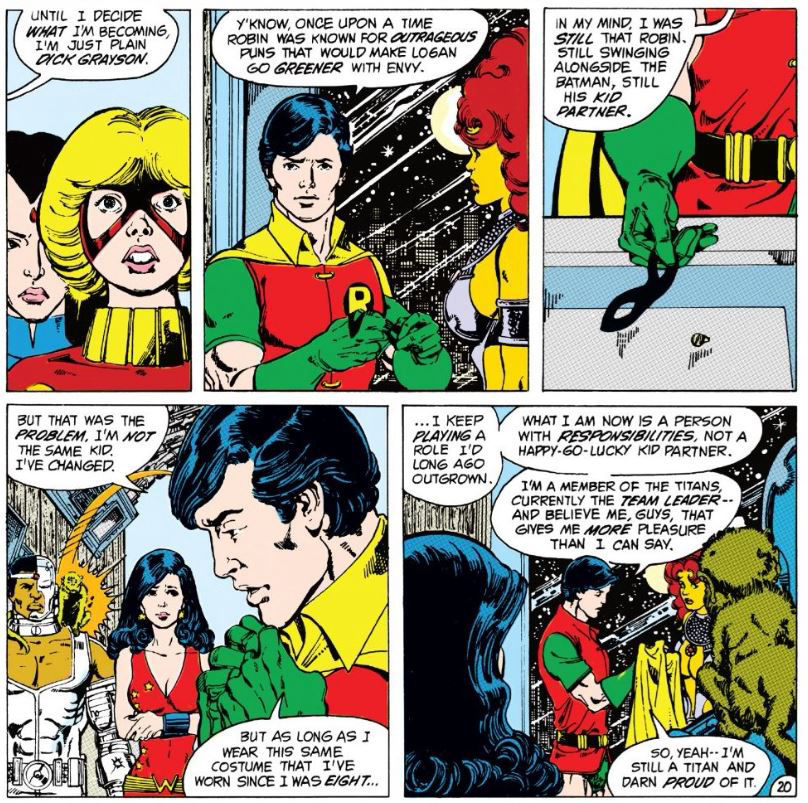
DICK: You know, once upon a time Robin was known for outrageous puns that would make Logan [the green-skinned Changeling, the young class-clown of the Titans] go greener with envy. In my mind, I was still that Robin. Still swinging alongside the Batman, still his kid partner. But that was the problem, I'm not the same kid. I've changed. But as long as I wear this same costume I've worn since I was eight ... I keep playing a role I've long outgrown.
What I am now is a person with responsibilities, not a happy-go-lucky kid partner. I'm a member of the Titans, currently the team leader -- and believe me, guys, that gives me more pleasure than I can say. So, yeah -- I'm still a Titan and darn proud of it. But I simply can't be Robin anymore. I have to become someone -- an adult. Whoever Dick Grayson decides to be.
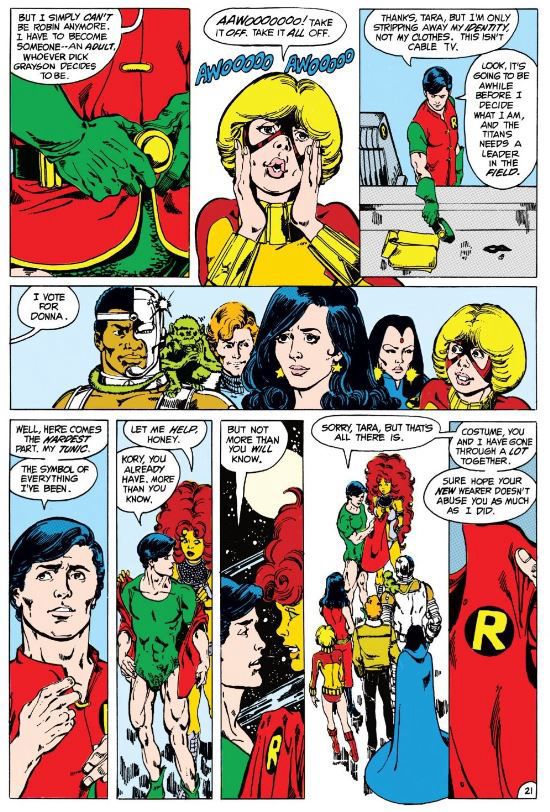
Starfire helps him off with his tunic -- "the symbol of everything I've been." Dick’s decision has brought him and Kory even closer together.
And with that -- the deed was done. Dick Grayson was no longer Robin.
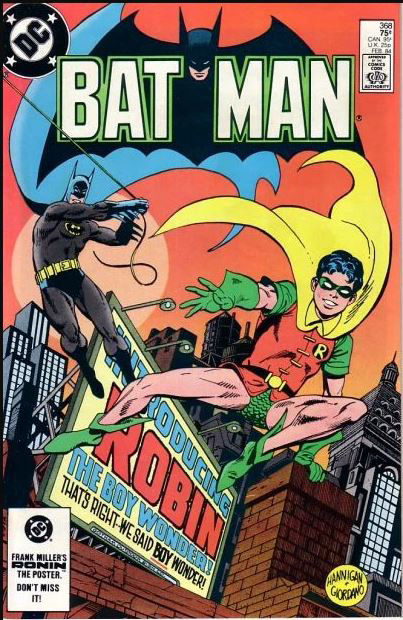
Back in the Batman comics, Jason Todd was already Robin, albeit briefly. In Batman #366 (December 1983) Jason finds one of Dick’s old costumes and dyes his hair black. As “Robin”, Jason rescues Batman from the Joker. Batman scolds his young ward for stealing someone else’s identity.
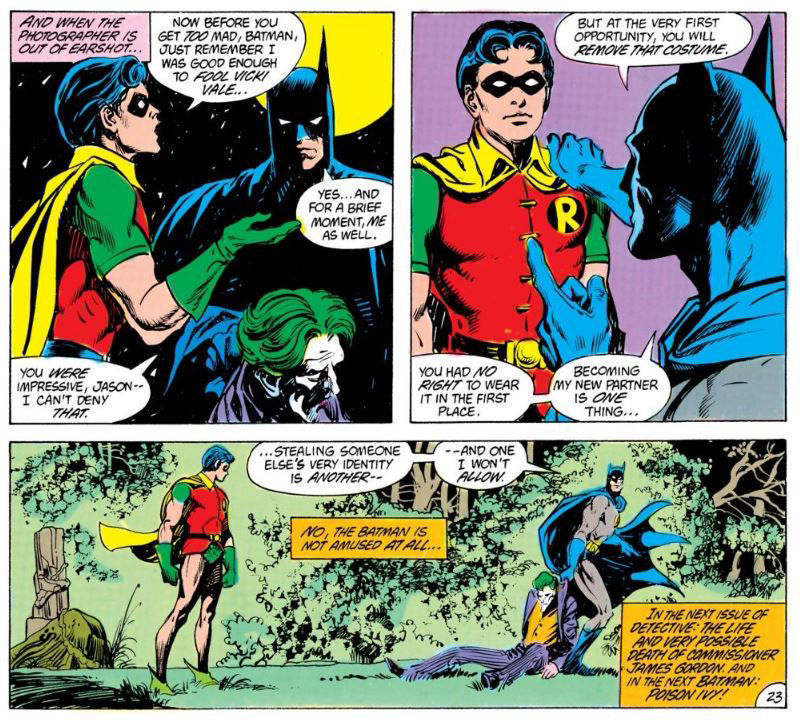
The next month, Jason is back in the makeshift very-Robin-like-but-not-Robin costume from Detective Comics #526, although now with black hair. While combating Poison Ivy, Batman accidentally calls Jason “Robin”.
The same month that Dick Grayson decided to drop his Robin identity in The New Teen Titans, the cover of Batman #368 (cover date: February 1984) declares “Introducing Robin the Boy Wonder – That’s right, we said BOY Wonder.” Robin was no longer the more mature “Teen Wonder” that he’d been since 1969.
The issue begins with Batman and Jason going through various possible superhero names – much as I suspect DC Comics had been while deciding whether Jason would assume the classic identity. Blue Jay? Cardinal? Finally Jason suggests Tonto – the name of the Lone Ranger’s partner. He declares all the code names sound dumb. But Dick Grayson stops by with a suggestion.
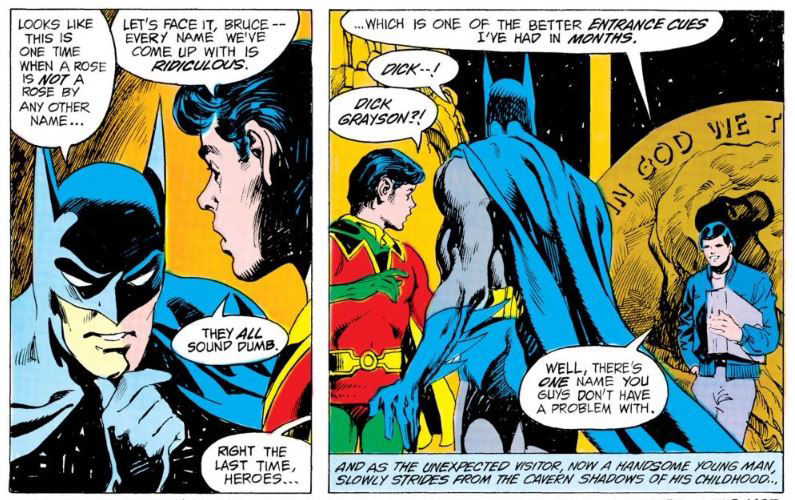
Dick explains that he’s brought something that should have never left Gotham City. Dick had seen reporter Vicki Vale’s photos of Jason as Robin from a couple issues before. He correctly deduces that if they are trying to come up with new names now that Bruce did not approve of Jason using the Robin identity. Jason insists he didn’t mean to steal Dick’s identity.
But Dick says it’s okay. He gives his Robin costume to Jason. You've just received a profound gift, Jay" says the Batman. "Put it on."
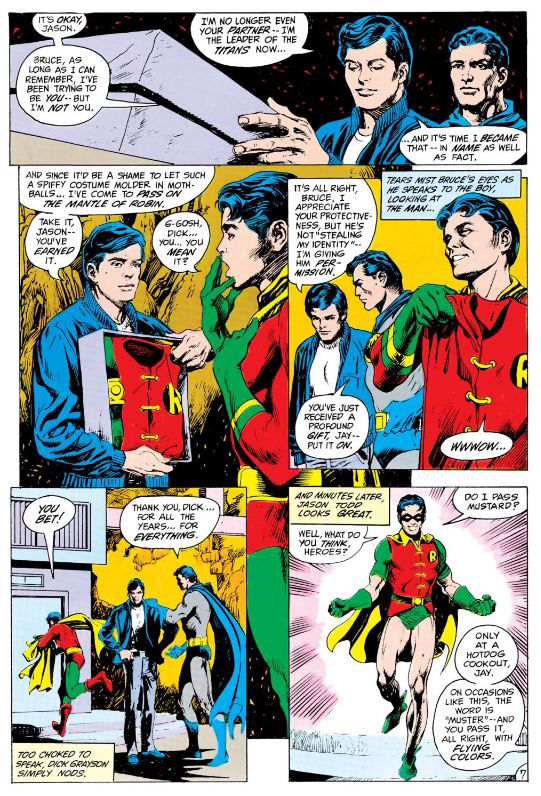
The Batman asks who Dick will become, and he considers being “plain old Dick Grayson for a time”.
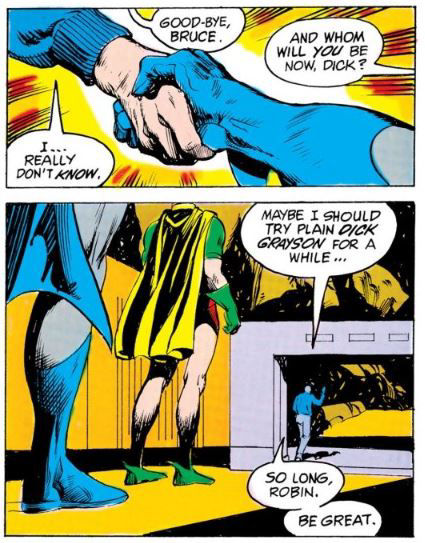
Indeed, over in The New Teen Titans, he does remain Dick Grayson for months. The comic book under went a title change to Tales of the Teen Titans, retitled to make way for the debut of a 2nd comic book series titled The New Teen Titans, a comic book that wouldn’t be distributed to newsstands or convenience stores but only the comic book specialty shops that were beginning to dominate the market. But before the new New Teen Titans comic could debut, the team’s leader needed a new identity.
In Tales of the Teen Titans #44 (July 1984) Dick Grayson takes on a new identity to rescue his fellow Titans from the clutches of their arch-enemy Slade Wilson aka Deathstroke the Terminator. The name Dick Grayson had chosen for himself was Nightwing. It was not a name that writer Marv Wolfman would have chosen. Quoted in “Taking Wing: Nightwing Moves Out from Under Batman’s Shadow” by Andy Mangels in Back Issue #73 (July 1984) Wolfman remarks “I dismissed Nightwing right away, because it was an obvious name, and to like a million different names, trying to come up with something.” But with the script due and no name seeming promising, colourist Anthony Tollin persuaded Wolfman to go with Nightwing, which Wolfman concedes “frankly, it was the best name available.”
Nightwing might sound an obvious choice for a character named Robin stepping into more of a Batman role – implying the wing of a bird or bat – but actually the name came from Superman comics. People not familiar with comic book lore might still know enough about Superman’s background to know he’s the survivor of the doomed planet Krypton. But what most may not know is that he’s not the only survivor. Before the planet exploded, the Kryptonian city of Kandor was shrunk down and placed in the intergalactic zoo of the villain Brainiac. Superman rescued the Kandorians and placed the bottle city in his Fortress of Solitude as he looked for a way to restore his fellow Kryptonians to full-size. Occasionally, Superman would shrink down and have adventures in Kandor. In 1963, when falsely accused of a crime Superman and his pal adopted the superhero identities of Nightwing and Flamebird – the Kryptonian equivalents of a bat and a robin.
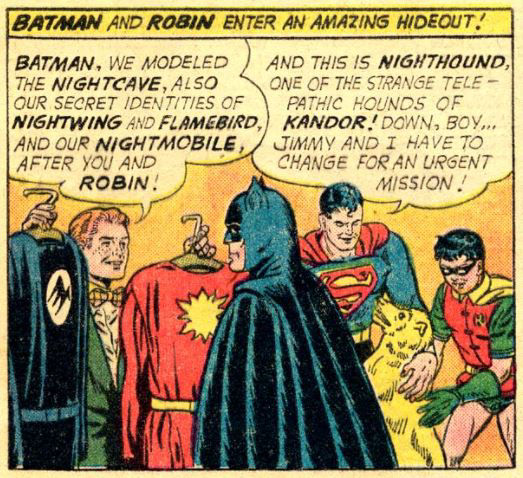
Starting in 1977, Superman’s lookalike Kandorian cousin Van-Zee took on the Nightwing identify for a series of adventures in Superman Family, although that comic was cancelled years before Dick Grayson was looking for a new identity.
Before trying on nis new look, Dick reflects on how his new identity is a tribute to the two people who inspired him to become the man that he is – Batman and Superman.
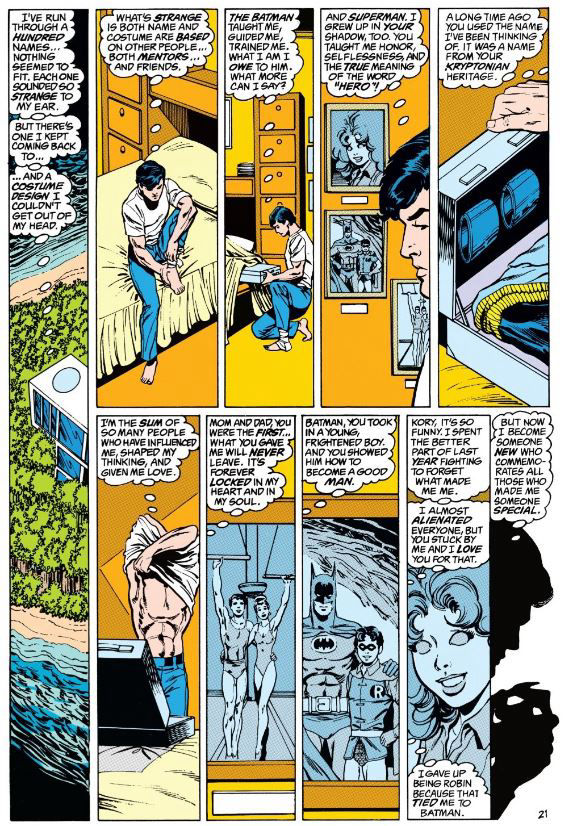
Dick Grayson's new costume was black and blue (or possibly dark blue and lighter blue) with yellow trim and disco collar. It was a costume very much of its time, and fans have observed that only artist George Perez could make it work.

The disco collar didn't last. Nor did the mullet and ponytail looks that would follow. But the change to Nightwing did last.
Oh, Dick Grayson might still be Robin in some film and TV adaptations, special flashback tales and alternate reality stories. But as far as main DC publishing line was concerned, Robin would be somebody else. Dick Grayson is the guy who was once Robin. It's astonishing to think that DC Comics was willing to commit to such a change for one of their most marketable characters. But then there was franchise opportunities in having separate comic book series for the past and current Robins.
As I've been making comparisons to contemporary Robin Hoods, it might be tempting to link this change of Robins to the 1984-1986 TV series Robin of Sherwood. At the end of the second series, Michael Praed's Robin of Loxley was killed, and Jason Connery played Robert of Huntingdon, who took up the mantle of Robin Hood in the third and final series. But this passing of the torch didn't come from a cultural zeitgeist but from the necessities of television production -- to replace an actor who had left the show to perform on the Broadway stage.
In the next section, I look at how the events of this section -- the transition from Robin to Nightwing -- have been changed over the years. I also look at what's happened to Dick Grayson since and how he's retained some Robin Hood qualities.
NEXT:
PART 10 - Reboots and Retcons (1984 - Present)
PREVIOUSLY:
PART 1 - The Golden Age of Comics and the Development of the Kid Sidekick
PART 2 -What's In A Name? Robin and Robin Hood
PART 3 - Early Adventures (including Robin's origin)
PART 4 - Batman and Robin meet Robin Hood in The Rescue of Robin Hood (Detective Comics #116)
PART 5: The Caped Crusaders in 1950s and 1960s Comic Books and Television
PART 6 - Batman and Robin Meet the Archer (1966 TV episodes)
PART 7 - Robin Leaves the Nest (1969 - 1975)
PART 8 - The Dynamite Duo and Goodbye, Hudson University (1975-1980)
Contact Us